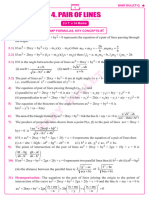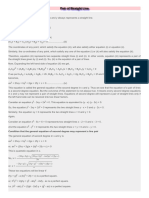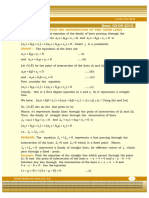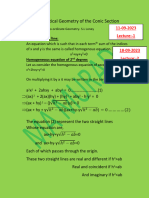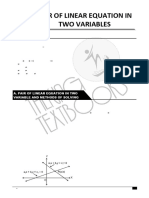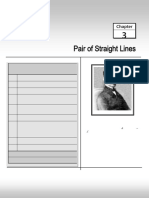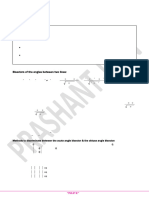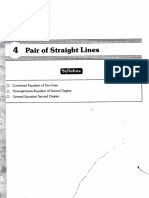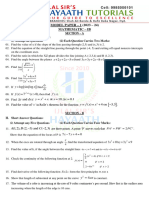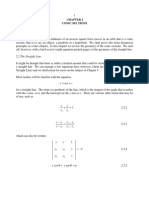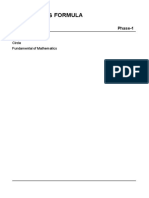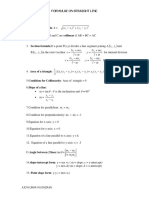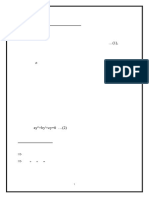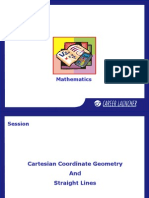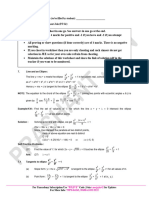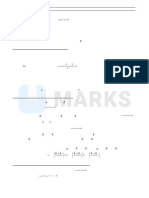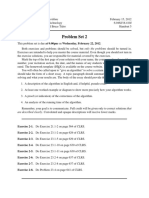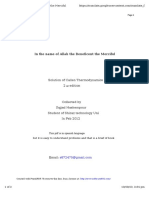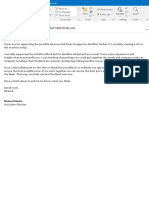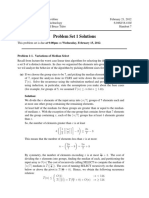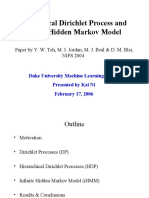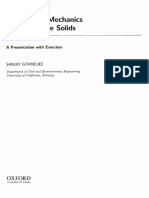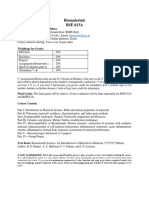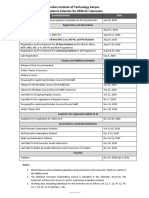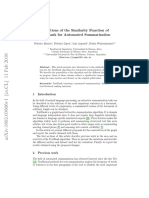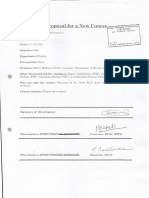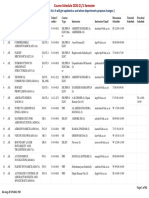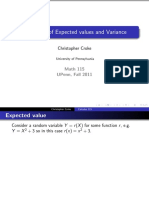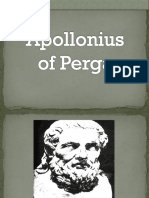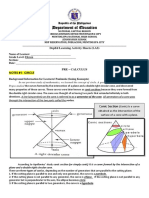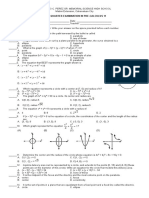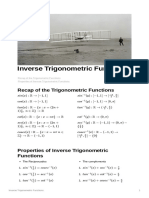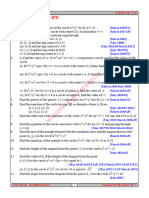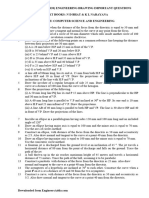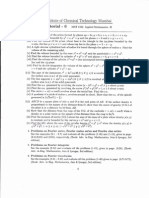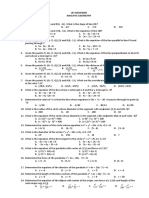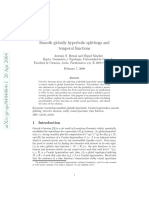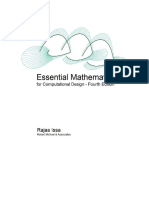Conic Section: 1.1 General Equation
Conic Section: 1.1 General Equation
Uploaded by
Yash VarunCopyright:
Available Formats
Conic Section: 1.1 General Equation
Conic Section: 1.1 General Equation
Uploaded by
Yash VarunOriginal Title
Copyright
Available Formats
Share this document
Did you find this document useful?
Is this content inappropriate?
Copyright:
Available Formats
Conic Section: 1.1 General Equation
Conic Section: 1.1 General Equation
Uploaded by
Yash VarunCopyright:
Available Formats
Vidyamandir Classes Conic
ConicSection
Section
Conic Section
PAIR OF LINES THROUGH ORIGIN Section - 1
1.1 General Equation
ax2 + 2hxy + by2 = 0 is a homogeneous equation of second degree that represents two straight line passing
through the origin. The individual equations of these straight lines can be obtained by factorising the expres
sion ax2 + 2hxy + by2 = 0 into two real linear factors. The equation represents two lines in real XY plane only
if h2 – ab 0.
1.2. Slopes of the lines
ax2 + 2hxy + by2 = 0
Let m1, m2 be the slopes of the lines through origin expressed by
ax2 + 2hxy + by2 = 0 . . . (i)
The lines are y = m1x and y = m2x and the equation of pair is (y – m1x) (y – m2x) = 0
m1m2x2 – xy (m1 + m2) + y2 = 0 . . . (ii)
m1m2 m1 m2 1
a 2h b
2h a
m1 m2 and m1 m2
b b
We can solve for m1 and m2 to get
2
h h 2 ab
m1 h h ab and m2
b b
Note : Again that h2 – ab 0 is the necessary condition for the equation representing real lines.
Illustration - 1 What does the equation x2 – 5xy + 4y2 = 0 represents?
SOLUTION :
x2 – 5xy + 4y2 = 0
x2 – 4xy – xy + 4y2 = 0 (x – 4y) (x – y) = 0
The equation represent two straight lines through origin whose Equations are :
x – 4y = 0 and x – y = 0.
Self Study Course for IITJEE with Online Support Section 1 1
Conic Section Vidyamandir Classes
1.3 Angle between the lines
ax2 + 2hxy + by2 = 0
If the acute angle between lines ax2 + 2hxy + by2 = 0
4h 2
4a
2
m1 m2 (m1 m2 ) 4m1m2 2 b
then tan b
1 m1 m2 1 m1m2 |1 a / b |
2 h2 ab
tan 1
ab
Hence we also have following results.
(i) The lines ax2 + 2hxy + by2 = 0 are mutually perpendicular if and only if a + b = 0.
i.e. coefficient of x2 + coefficient of y2 = 0.
(ii) The lines ax2 + 2hxy + by2 = 0 are coincident if h2 – ab = 0.
1.4 Angle bisector of lines
ax2 + 2hxy + by2 = 0.
Let m1, m2 be the slopes of lines ax2 + 2hxy + by2 = 0.
lines are y – m1 x = 0 and y – m2 x = 0 [m1 + m2 = – 2h/b and m1m2 = a/b]
bisectors of angles are :
y m1x y m2 x
1 m12
1 m2
1 m22 y m1x 2 1 m12 y m2 x 2 0
2
On simplification we get :
– y2 (m1 + m2) + x2 (m1 + m2) – 2xy (1 – m1m2) = 0
2 xy (1 m1m2 )
x2 y 2
m1 m2
2 xy (1 a / b)
x2 y 2
2h / b
x 2 b 2 xy
The equation of Bisectors is .
a b h
2 Section 1 Self Study Course for IITJEE with Online Support
Vidyamandir Classes Conic Section
Conic Section
1.5 Pair of lines perpendicular to the lines
Let L1 and L2 be the lines ax2 + 2hxy + by2 = 0.
Let P1 be the line Perpendicular to L1 and P2 be the line perpendicular to L2.
We have to find equation of P1P2.
Let L1 be y – m1x = 0 and L2 be y – m2x = 0
P1 is m1y + x = 0 and P2 is m2 y + x = 0
Pair P1P2 is (m1y + x) . (m2 y + x) = 0
m1 m2 y2 + xy (m1 + m2) + x2 = 0
a 2 2h
y xy x 2 0
b b
bx2 – 2hxy + ay2 = 0 is the equation of the pair of lines perpendicular to the pairs of lines
ax2 + 2hxy + by2 = 0.
Note : By interchanging the coefficients of x2 and y2 and reversing the sign of the xy term, we can get equation
of P1P from L1L2.
Illustration - 2 Find the area formed by the triangle whose sides are y2 – 9xy + 18x2 = 0 and y = 9.
SOLUTION :
y2 – 9xy + 18x2 = 0
(y – 3x) (y – 6x) = 0
The sides of the triangle are : y – 3x = 0 and y – 6x = 0 and y – 9 = 0.
By solving these simultaneousy, we get the vertices as :
A (0, 0) ; B (3/2, 9) ; C (3, 9)
0 0 1
1 3 27
Area 9 1 sq. units.
2 2 4
3 9 1
Illustration - 3 Find the angle between the lines x2 + 4y2 – 7xy = 0.
SOLUTION :
7
2 1(4)
tan 1
2 h ab
tan 1
2 2 tan 1 33 .
ab 1 4 5
Self Study Course for IITJEE with Online Support Section 1 3
Conic Section Vidyamandir Classes
Illustration - 4 Find the equation of pair of lines through origin which form an equilateral triangle with
the lines Ax + By + C = 0. Also find the area of this equilateral triangle.
SOLUTION :
Let PQ be the side of the equilateral triangle lying on the line Ax + By + C = 0. Let m be the slope of the
line through origin and making an angle of 60° with Ax + By + C = 0.
m is the slopes of OP or OQ.
As the triangle is equilateral, the line Ax + By + C = 0 makes an angle 60° with OP and OQ.
m ( A / B ) Y
tan 60
A
1 m P
B Q
2
mB A
3 . . . (i) O
X
B mA
This quadratic will give two values of m which are slope of OP and OQ. As OP and OQ pass through origin,
their equations can be taken as :
y = mx . . . (ii)
As we have to find the equation of OP and OQ, we will not find values of m but we will eliminate m between
(i) and (ii) to directly get the equation of the pairs of lines : OP and OQ.
2 2
By / x A By Ax
3
B yA / x Bx yA
3 (B2x2 + y2A2 – 2ABxy) = (B2x2 + A2x2 + 2ABxy)
(A2 – 3B2) x2 + 8ABxy + (B2 – 3A2) y2 = 0 is the pair of lines through origin making an equilateral
triangle (OPQ) with Ax + By + C = 0.
2
3 3 P
Area of OPQ (side) 2 [where P = altitude]
4 4 sin 60
2
3 4 2 12 2 1 | C | C2
area P P
4 3 3 3 A2 B 2
3 ( A2 B 2 )
Illustration - 5 If a pair of lines x2 – 2pxy – y2 = 0 and x2 – 2qxy – y2 = 0 is such that each pair bisects the
angle between the other pair, prove that pq = – 1.
SOLUTION :
The pair of bisectors for x2 – 2pxy – y2 = 0 is
4 Section 1 Self Study Course for IITJEE with Online Support
Vidyamandir Classes Conic Section
x 2 y 2 xy
1 (1) p
2xy 2
x2 y 2 x2 xy y 2 0
p p
2
As x 2 xy y 2 0 and x2 – 2qxy – y2 = 0 coincide,
p
we have :
1 2 / p 1 2
2q
1 2q 1 p
pq = – 1.
Illustration - 6 Prove that the angle between one of the lines given by ax2 +2hxy + by2 = 0 and one of the
lines ax + 2hxy + by2 + (x2 + y2) = 0 is equal to the angle between the other two lines of the system.
2
SOLUTION :
Let L1L2 be one pair and P1P2 be other, if the angle between L1P1 is equal to the angle between L2P2, the
pair of bisectors of L1L2 is same as that of P1P2.
Y
Pair of bisectors of P1P2 is : L 1
2 2 2 2
x y xy x y xy P1
(a ) (b ) h a b h
X
This is same as the bisector pair of L1L2. O
P2
Hence the statement is proved. L2
Illustration - 7 Show that the orthocentre of the triangle formed by the lines ax2 + 2hxy + by2 = 0 and lx + my
x y ab
= 1 is given by .
l m am 2hlm bl 2
2
SOLUTION :
Let the triangle be OBC where O is origin and BC is the line lx + my = 1.
Y
OB, OC are ax2 + 2hxy + by2 = 0.
m
The altitude from O to BC is y – 0 = ( x 0) mx – ly = 0 B
l
Let OB : y – m1x = 0 and OC : y – m2x = 0.
C
1 m1 X
B , O
l mm1 l mm1
Self Study Course for IITJEE with Online Support Section 1 5
Conic Section Vidyamandir Classes
Slope of altitude from B to OC is – 1/m2
The equation of altitude from B is
m1 1 1
y x
l mm1 m2 l mm1
(l + mm1) x + m2 (l + mm1) y – (1 + m1m2) = 0 . . . (i)
mx – ly + 0 = 0 . . . (ii)
Solving (i) and (ii), we get orthcentre :
x y 1
l (1 mm1 ) m (1 m1m2 ) l (l mm1) mm2 (l mm1)
x y (1 a / b)
l m l 2 m2 m1m2 lm (m1 m2 )
x y ab
[using values of m1m2 and m1 + m2]
l m bl am 2 2hlm
2
PAIR OF LINES IN GENERAL Section - 2
2.1 General form
ax2 + 2hxy + by2 + 2gx + 2fy + c = 0 is the general second degree equation and represents conics (pairs
of lines, parabola, hyperbola, Ellipse and circle).
This equation represents a pair of lines in the XY plane if the expression on LHS can be factorized into two
real linear factors in terms of x, y. The condition for this is :
abc + 2fgh – af 2 – bg2 – ch2 = 0 [and h2 – ab 0]
a h g
h b f 0
or in determinant form, [and h2 – ab 0]
g f c
6 Section 2 Self Study Course for IITJEE with Online Support
Vidyamandir Classes Conic Section
Illustration - 8 Prove that the equation 6x2 – xy – 12y2 – 8x + 29y – 14 = 0 represent a pair of lines. Find
the equations of each line.
SOLUTION :
Using the condition given above in (i), we have : 6x2 – xy – 12y2 = 6x2 – 9xy + 8xy – 12y2
6 1/ 2 4 = (3x + 4y) (2x – 3y).
a h g Let the factors be 3x + 4y + c1 and 2x – 3y + c2.
29
h b f 1/ 2 12 0 6x2 – xy – 12y2 – 8x + 29y – 14
2 = (3x + 4y + c1) (2x – 3y + c2).
g f c
29 Comparing the coefficients of x and y, we get :
4 14
2 – 8 = 3c2 + 2c1 and 29 = 4c2 – 3c1
Hence the given equation represents a pair of On solving for c1 and c2, we get c2 = 2 and c1 = – 7
The lines are 3x + 4y – 7 = 0 and 2x – 3y + 2
lines. To find the equation of each line, we have
= 0.
to factories the LHS we first factories the second
degree term.
2.2 Angle between the lines
2
1 2 h ab
ax2 + 2hxy + by2 + 2gx + 2fy + c = 0 is = tan .
ab
2.3 Point of intersection of lines
bg hf af gh
ax2 = 2hxy + by2 + 2gx + 2fy + c = 0 is 2 , .
2
h ab h ab
2.4 Equation of pair of lines joining origin to the point of intersection of lx + my + n =
0 and the conic ax2 + 2hxy + by2 + 2gx + 2fy + c = 0
Let the line lx + my + n = 0 cuts the curve ax2 + 2hxy + by2 + 2gx + 2fy + c = 0 in pionts P and Q.
The equations of pair of lines OP and OQ (where O is the origin), joining origin O to P and Q, can be found
by making the equation of curve homogeneous with the help of equation of the line lx + my + n = 0.
First write the equation of curve as :
ax2 + 2hxy + by2 + (2gx + 2fy) . 1 + c (1)2 = 0
lx my
Since write the equation of line is : lx + my + n = 0 1
n
Substituting the value of 1 in above equation, we get :
2
lx my lx my
ax + 2hxy + by – (2gx + 2fy)
2 2
c 0
n n
as the equation of pair of lines OP and OQ.
Self Study Course for IITJEE with Online Support Section 2 7
Conic Section Vidyamandir Classes
Illustration - 9 Find the equation of the lines joining the origin to the points of intersection of the line 4x –
3y = 10 with the circle x2 + y2 + 3x – 6y – 20 = 0 and show that they are perpendicular.
SOLUTION :
4x 3y
We will make the equation of circle homogeneous by using 1 = .
10
2
2 2 4x 3 y 4x 3 y
The pair of lines is x y (3x 6 y ) 20 0.
10 10
10x2 + 15xy – 10y2 = 0.
Since the coefficient x2 + coeff. of y2 = 10 – 10 = 0.
They are perpendicular.
The equation can also be asked as :
[Show that the chord 4x – 3y = 10 of the circle x2 + y2 + 3x – 6y – 20 = 0 subtends a right angle at origin.]
Illustration - 10 A variable chord of the circle x2 + y2 + 2gx + 2fy + c = 0 always subtends a right angle at
origin. Find the locus of the foot of the perpendicular drawn from origin to this chord.
SOLUTION :
Let the variable chord be lx + my = 1 [where l, m are changing quantities]
[i.e. parameters that change with the moving chord]
Let P (x1, y1) be the foot of the perpendicular from origin to the chord.
If AB is the chord, the equation of OA and OB is x2 + y2 + (2gx + 2fy) (lx + my) + C (lx + my)2 = 0.
x2 (1 + 2gl + cl2) + y2 (1 + 2fm + cm2) + (2gm + 2f l + 2clm) xy = 0
As OA perpendicular OB, (1 + 2gl + cl2) + (1 + 2fm + cm2) = 0 . . . (i)
P lies on AB. lx1 + my1 = 1 . . . (ii)
y1 l
OP AB 1 . . . (iii)
x1 m
We have to eliminate l, m using (i), (ii), (iii).
From (ii) and (iii), we get :
y1 x1
m and l
x12 y12 x12 y12
Now from (i), we get :
2 gx1 cx12 2 fy1 cy12
2 0
x12 y12 ( x12 y12 )2 x12 y12 ( x12 y12 )2
8 Section 2 Self Study Course for IITJEE with Online Support
Vidyamandir Classes Conic Section
2 (x12 + y12) + 2gx1 + 2fy1 + c = 0
The locus of P is : 2 (x2 + y2) + 2gx + 2fy + c = 0.
PARABOLA Section - 3
3.1 Section of a right Circular Cone by different planes
(i) Section of a right circular cone by a plane which is passing through its vertex is a pair of straight lines,
lines always passes through the vertex of the cone.
Here VA and VB are lines where V is vertex of cone.
Plane
P A O Q
B
(ii) Section of a right circular cone by a plane which parallel to its base is a circle.
Plane
Circle
P O Q
Self Study Course for IITJEE with Online Support Section 3 9
Conic Section Vidyamandir Classes
(iii) Section of a right circular cone by a plane which is parallel to a generator of the cone is a parabola.
Generator Plane
Parabola
P O Q
(iv) Section of a right circular cone by a plane which is not parallel to any generator and not parallel or
perpendicular to the axis of the cone is an ellipse.
V
Plane
Parabola
P O Q
(v) Section of a right circular cone by a plane which is parallel to the axis of the cone is a hyperbola.
Hyperbola
Axis
10 Section 3 Self Study Course for IITJEE with Online Support
Vidyamandir Classes Conic Section
3.2 Definition of Conic
Conic section is defined as a locus of a point (P) in a plane which moves in such a way, that ratio of its
distances from a fixed point (called focus of conic, say S) and from a fixed line (called directrix of conic,
say L) is constant (called the eccentricity of conic, denoted by ‘e’).
PS
i.e. = constant (eccentricity e)
PN
In other words ‘a conic section may be defined as the locus
N P (Moving point)
of a point which moves such that the ratio of its distance from
focus to its distance from directrix is a constant’.
Let P (h, k), S (x1, y1) and L Ax + By + C = 0 S (Fixed point of Focus)
PS
=e PS = e PN
PN
L (Fixed line or Directrix)
Ah Bk C
(h x1)2 (k y1 )2 e
A2 B 2
( Ah Bk C ) 2
( h x1) 2 ( k y1 ) 2 e 2
A2 B 2
Hence, locus of moving point P (h, k), i.e. equation of conic is given by
(A2 + B2) {(x – x1)2 + (y – y1)2} = e2 (Ax + By + C)2
Eccentricity and Shape of Conic Section
e = 1 : Parabola
e < 1 : Ellipse
e > 1 : Hyperbola
e = 0 : Circle (special case of ellipse)
Note : that as ‘e’ is the ratio of distances, so ‘e’ cannot be negative.
Self Study Course for IITJEE with Online Support Section 3 11
Conic Section Vidyamandir Classes
Illustration - 11 Find the locus of a point, which moves such that its distance from the point (0, –1) is twice
its distance from the line 3x + 4y + 1 = 0.
SOLUTION :
Let P (x1, y1) be the point, whose locus is Squaring and simplifying, we have
required. 25 ( x12 y12 2 y1 1)
Its distance from (0, –1) = 2 × Its distance from = 4 (9x12 + 16 y12 + 1 +24x1y1 + 6x1 + 8y1)
the line 3x + 4y + 1 = 0,
11x12 39 y12 96 x1 y1 24 x1 18 y
2 2
( x1 0) ( y1 1)
21 0
|3 x1 4 y1 1|
2 Hence the locus of (x1, y1) is
2 2
(3 4 )
11x2 + 39y2 + 96xy + 24x1 – 18y – 21 = 0.
5 x12 ( y12 1) 2 | 3x1 4 y1 1|
Illustration - 12 What conic does the equation 25 [x2 + y2 – 2x + 1] = (4x – 3y + 1)2 represent?
SOLUTION :
The given equation is 2
2 2
4x 3 y 1
25 [x2 + y2 – 2x + 1] = (4x – 3y + 1)2 . . . (i) 25[( x 1) ( y 0) ] 25
2 2
4 3
Write the right hand side of this equation, so that
| 4 x 3 y 1|
it appears in perpendicular distance form to get : ( x 1)2 ( y 0)2
2 42 32
4x 3 y 1
R.H.S. = (4 x 3 y 1)2 25 Here e = 1.
(42 32 )
Thus the given equation represents a parabola. It
then equation (i) can be re-written as may noted that (1, 0) is the focus and 4x – 3y + 1
= 0 is the directrix of the parabola.
3.3 Conditions for Second Degree Equation to Represent Various Conic Section
The equation of conic represented by the general equation of second degree in two variables is given by
ax2 + 2hxy + by2 + 2gx + 2fy + c = 0
The discriminant of the above equation is represtned by
a h g
2 2 2
abc 2 fgh af bg ch h b f
g f c
12 Section 3 Self Study Course for IITJEE with Online Support
Vidyamandir Classes Conic Section
Case I : When = 0
In this case above equation represents the Degenerate conic. The nature of conic is given below :
Condition Shape
= 0 and h2 = ab A pair of coincident straight lines
= 0 and h2 > ab A pair of real straight lines
= 0 and h2 < ab A pair of Imaginary straight line
Case II : When 0
In this case above equation represents the Non-degenerate conic. The nature of conic is given below :
Condition Shape
0, h = 0, a = b a circle
0, h2 = ab a parabola
0, h2 < ab an Ellipse
0, h2 > ab a Hyperbola
0, h2 > ab and a + b = 0 a rectangular hyperbola
Illustration - 13
What conic does 13x2 – 18xy + 37y2 + 2x + 14y – 2 = 0 represent?
SOLUTION :
Compare the given equation with
= – 962 – 126 – 637 – 37 + 162
ax2 + 2hxy + by2 + 2gx + 2fy + c = 0 = – 1600 0
a = 13, h = – 9, b = 37, g = 1, f = 7, and also
c=–2 h2 = (–9)2 = 81 and ab = 13 × 37 = 481
then = abc + 2f gh – af 2 – bg2 – ch2 Here ab – h2 = 400 > 0
= (13) (37) (–2) + 2 (7) (1) (–9) – 13 So we have h2 < ab and 0. Hence the given
(7)2– 37 (1)2 + 2 (–9)2 equation represents an ellipse.
Self Study Course for IITJEE with Online Support Section 3 13
Conic Section Vidyamandir Classes
Illustration - 14 If the equation of conic 2x2 + xy + 3y2 – 3x + 5y + = 0 represent a single point, then find
the value of .
SOLUTION :
For single point Given conic represents a single point if = 0.
2
h < ab and = 0 and = abc + 2f gh – af 2 – bg2 – ch2
Comparing the given equation with 5 3 1 25
ax2 + 2hxy + by2 + 2gx + 2fy + c = 0 (2) (3) ( ) 2 2
2 2 2 4
1 3 5 9 1
then a 2, h , b 3, g , f , c 3 0
2 2 2 4 4
Here h2 ab 1 6 23 0 6
15 25 27
0
4 4 4 2 4 4
23
23 0 = 4.
4
3.4 Definition of Parabola
A parabola is the locus of a point which moves in a plane such that its distance from a fixed point (i.e. focus)
is always equal to its distance from a fixed straight line (i.e. directrix).
3.5 Standard Parabola (y2 = 4ax)
The general form of standard parabola is :
y2 = 4ax, [where ‘a’ is a constant]
Y
directrix
Q
M P
L
–a O X
S (a, 0) N axis
x+a=0
P
L
y2 = 4ax Q
x=–a
3.6 Important terms related with standard Parabola y2 = 4ax
(i) The straight line passing through the focus and perpendicular to the directrix is called the Axis of the
Parabola. The parabola is symmetrical about its axis (i.e. y = 0 line). It means if (x, y) lies
on parabola, then (x, –y) also lies on other sides of the axis.
14 Section 3 Self Study Course for IITJEE with Online Support
Vidyamandir Classes Conic Section
(ii) The point which bisects every chord of the conic passing through it, is called the Centre of the
Parabola.
(iii) The points of intersection of the conic section and the axis is (are) called Vertex. Veretex is point A
(0, 0) i.e. the origin is the vertex of the parabola
(iv) The fixed point is known as Focus (denoted by S).
(v) The fixed line is known as Directrix.
(vi) A chord passing through the focus is known as Focal Chord.
(vii) The straight line through focus and perpendicular to directrix is known as Axis.
(viii) The focal chord which is perpendicular to the axis is known as Latus Recturm. As double ordinate
LL passes through the foucs. Since focus S (a, 0) the equation of the latus rectum of the parabola is
x=a
then solving x = a and y2 = 4ax
then we get y = ± 2a
Hence the co-ordinates of the extremities of the latus rectum are L (a, 2a) and L (a, – 2a) respec-
tively.
Since LS = LS = 2a
Length of latus rectum LL = 2 (LS) = 2 (LS) = 4a.
(ix) If Q be the point of the parabola, draw QN perpendicular to the axis of parabola and produced to
meet the curve again at Q, then QQ is called a double ordinate.
If abscissa of Q is h then ordinate of Q, y2 = 4ah
or y 2 ah (for first quadrant)
and ordinate of Q is y 2 ah (for fourth quadrant)
Hence co-ordinates of Q and Q are ( h, 2 ah ) and ( h, 2 ah ) respectively..
(x) The Parametric Equations : From the equation of the parabola y2 = 4ax, we can write
y 2x
t where ‘t’ is a parameter. Then
2a y
y = 2at and x = at2
The equations x = at2 and y = 2at are called parametric equations :
The point (at2, 2at) is also referred to as the point ‘t’.
Note : Co-ordinates of any point on the parabola y2 = 4ax, may be taken as (at2, 2at).
Self Study Course for IITJEE with Online Support Section 3 15
Conic Section Vidyamandir Classes
3.7 Other forms of Parabola
y2 = 4 ax y2 = – 4ax x2 = 4 ay x2 = – 4 ay
Parabola Parabola Parabola Parabola
towards right towards left opening upwards opening downwards
Vertex (0, 0) (0, 0) (0, 0) (0, 0)
Focus (a, 0) (– a, 0) (0, a) (0, – a)
Equation of axis y=0 y=0 x=0 x=0
Equation of directrix x+a=0 x–a=0 y+a=0 y–a=0
Length of latus rectum 4a 4a 4a 4a
Extremities of Latus rectum (a, ± 2a) (–a, ± 2a) (± 2a, a) (± 2a, –a)
Equation of latus rectum x–a=0 x+a=0 y–a=0 y+a
Equation of tangent at vertex x = 0 x =0 y=0 y=0
Parametric co-ordinates (at2, 2at) (–at2, 2at) 2
(2at, at ) (2at, –at2 )
Y Y
Y Y
M L P L Z M
P S
M L L
Figure X X X X
P X A X
Z A S S A Z X X
A P
L L L L
S
Y Y Z M
Y Y
Illustration - 15 Find the coordinates of focus, vertex, equation of directrix, tangent at vertex, axis and
length of latus of rectuum for the following parabolas.
(i) y2 = 6x (ii) x2 = 8y (iii) y2 = – 16x (iv) x2 = – 12y
SOLUTION :
3 3
(i) y2 4 · ·x a
2 2
3
Focus : (a, 0) , 0 Vertex : (0, 0)
2
3
Directrix : x = – a x = Tangent at vertex x = 0
2
Axis : y = 0 Length of latus recturm = 4a = 6
(ii) x2 = 8y = 4.2 . y a=2
Focus : (0, a) (0, 2) Vertex : (0, 0)
Directrix : y = – a y = – 2 Tangent at vertex y = 0
Axis : x = 0 Length of latus recturm = 8
16 Section 3 Self Study Course for IITJEE with Online Support
Vidyamandir Classes Conic Section
(iii) y2 = – 16x = – 4.4x a = 4
Focus : (– a, 0) (– 4, 0) Vertex : (0, 0)
Directrix : x = a x = 4 Tangent at vertex y = 0
Axis : y = 0 Length of latus recturm = 16
(iv) x2 = – 12y = – 4.3y a = 3
Focus : (0, – a) (0, – 3) Vertex : (0, 0)
Directrix : y = a y = 3 Tangent at vertex y = 0
Axis : x = 0 Length of latus recturm = 4a = 12
3.8 General Form of Parabola
Finding equation of parabola when focus and line of directrix are given
Assume that the focus as S (h, k), line of directrix as ax + by + c = 0 and point P as (x1, y1) (, )
whose locus is parabola.
As we know that for parabola,
PS = PN PS2 = PN2
2
ax by1 c
( x1 h)2 ( y2 k )2 1
. . . (i)
a 2 b2
Simplifying the equation (i), and then replacing ‘x1’ by ‘x’ and ‘y1’ by ‘y’, we will get the required equation
to parabola. The simplified form of general equation of parabola would look line.
(bx – ay)2 + 2gx + 2fy + c = 0. Where g f and c are real constants.
Note : The second degree terms in the general equation of parabola forms a perfect square.
Illustration - 16 Find the equation of the parabola whose focus is at (–1, –2) and the directrix is the straight
line x – 2y + 3 = 0.
SOLUTION :
Let P (x, y) be any point on the parabola whose focus is
S (–1, –2) and the directrix x – 2y + 3 = 0.
Draw PM perpendicular from P (x, y) on the directrix M P (x, y)
x – 2y + 3 = 0. Then by definition
x – 2y + 3 = 0
SP = PM
(SP)2 = (PM)2
S (–1, –2)
Self Study Course for IITJEE with Online Support Section 3 17
Conic Section Vidyamandir Classes
2
2 2 | x 2y 3|
( x 1) ( y 2)
(1)2 (2) 2
5 (x2 + y2 + 2x + 4y + 5) = (x2 + 4y2 – 4xy+ 6x – 12y + 9)
4x2 + y2 + 4xy + 4x + 32y + 16 = 0.
Illustration - 17 Find the points as the parabola y2 = 8x whose focal distance is 8.
SOLUTION :
Y
Comparing y2 = 8x with y2 = 4ax
4a = 8 M P (x1, y1)
Directrix
a=2 Focal
We know focal distance of (at2, 2at) distance = 8
X
= a (1 + t2) = 8 Z A S
x+2=0
1 + t2 = 4
t 3
Points on the parabola are (at2, 2at) where t 3 .
The required points are ( 6, 4 3 ) and ( 6, 4 3 ).
Illustration - 18 Find the length of the side of an equilateral triangle inscribed in the parabola y2 = 4ax so
that one angular point is at the vertex.
SOLUTION :
Let ABC be the inscribed equilateral triangle, 2
l l 3
with one angular point at the vertex V of the 4a l 8a 3
2 2
parabola.
y2 = 4ax . . . (i)
Y
Let the length of the side of equilateral triangle
B
=l
AB = BC = CA = l l
The co-ordinates of B is X 30°
X
A 30°
(l cos 30°, l sin 30°) l
l 3 l
C
i.e., 2 , 2 . As B lies on (i), then we get :
Y
18 Section 3 Self Study Course for IITJEE with Online Support
Vidyamandir Classes Conic Section
Illustration - 19 Find the vertex, focus, latus rectum, axis and the directrix of the parabola x2 + 8x + 12y +
4 = 0.
SOLUTION :
The equation of parabols is Vertex of (i) is (–4, 1).
x2 + 8x + 12y + 4 = 0 . . . (i) Focus of (iii) is (0, – 3)
(x + 4)2 – 16 + 12y + 4 = 0 i.e., X = 0, Y = – 3
(x + 4)2 = 12 – 12y Using (ii), x + 4 = 0, y – 1 = – 3
(x + 4)2 = – 12 (y – 1) x = – 4, y = – 2
Let x + 4 = X, y – 1 = Y . . . (ii) focus of (i) is (–4, –2) and
X2 = – 12Y . . . (iii) latus rectum = 4a = 12.
Comparing it with X 2 = – 4aY, we get : Equation of axis of (iii) is X = 0
a=3 Equation of axis of (i) is x + 4 = 0
Also Vertex of (iii) is (0, 0) Equation of directrix of (iii) is
i.e. X = 0, Y = 0 Y=3
Using (ii) y–1=3 y–4=0
x + 4 = 0, y – 1 = 0 Equation of directrix of (i) is y – 4 = 0.
x = – 4, y = 1
Illustration - 20 11 3 15 3
A parabola whose vertex is , and focus is , . Find its length of latus
8 2 8 2
recturm.
SOLUTION :
V is mid-point of N and F. 64x2 + 240x + 225 + 64y2 – 192y + 144
15 = 64x2 + 112x + 49
7
11
2
8 y – 3y + 2x + 5 = 0
8 2 8
Axis is perpendicular to directrix and passing through
3
3 3
and 3 2 focus and hence equation of axis is given by y .
2 2 2 2
Directrix is line passing through N and perpendicu- Length of latus rectum = 2 × Distance of focus from
lar to VF.
15 7
7 directrix 2 2.
Equation of directrix is x 8 8
8 Y
Equation of parabola becomes _3
y=
2
2 2 X
15 3 7 N (, ) V F
x y x –11, _3 –15, _3
8 2 8 8 2 8 2
(8x +15)2 + 16 (2y – 3)2 = (8x + 7)2 Directrix
Self Study Course for IITJEE with Online Support Section 3 19
Conic Section Vidyamandir Classes
Illustration - 21 If a double ordinate y2 = 4ax is of length 8a, then prove that triangle formed by double
ordinate and lines joining vertex with end points of double ordinate is a right-angled triangle.
SOLUTION :
(, 4a) lies on y2 = 4ax Hence, OAA is right-angled triangle.
16a2 = 4a = 4a
Y
4a 0
Slope of OA 1 m1 A (, 4a)
4a 0
4a 0 4a
Slope of OA 1 m2
4a 0
X
O (, 0)
m1 m3 = – 1 OA OA ' 4a
A (, – 4a)
Illustration - 22 Find the equation of the parabola with its vertex at (3, 2) and its focus at (5, 2).
SOLUTION :
Let Vertex A (3, 2) and focus is S (5, 2). Y
22
Slope of AS 0 (3, 2)
53
A S (5, 2)
(which is parallel to x-axis)
The equation is of the form
(y – k)2 = 4a (x – h) X
O
(y – 2)2 = 4a (x – 3)
as (h, k) is the vertex (3, 2) Hence the required equation is
a = distance between the focus and the vertex
(y – 2)2 = 8 (x – 3)
= (5 3)2 (2 2) 2 = 2 y2 – 8x – 4y + 28 = 0
20 Section 3 Self Study Course for IITJEE with Online Support
Vidyamandir Classes Conic Section
Illustration - 23 Show that the focal chord of parabola y 2 = 4ax makes an angle with the x-axis
is of length 4a cosec2 .
SOLUTION :
Let P (at12, 2at1) and Q (at22, 2at2) be the end tan = slope of PQ
points of a focal chord PQ which makes an angle 2at2 2at1 2
with the axis of the parabola. Then = tan
at22 at12 t2 t1
PQ = a (t2 – t1)2
t2 + t1 = 2 cot . . . (ii)
= a ((t2 + t1)2 – 4 t1t2)
Substituting the value of t2 + t1 from (ii) in (i) then
= a ((t2 + t1)2 + 4) . . . (i)
PQ = a (4 cot2 + 4)
[as t1t2 = – 1]
= 4a cosec2 .
A LINE AND A PARABOLA Section - 4
4.1 Intersection of a line and parabola
Let the parabola be y2 = 4ax . . . (i)
and the given line be y = mx + c . . . (ii)
Eliminating y from (i) and (ii), then
(mx + c)2 = 4ax
m2x2 + 2x (mc – 2a) + c2 = 0 . . . (iii)
This equation, being quadratic in x, gives two values of x. Shows that every straight line will cut the parabola
in two points may be real, coincident or imaginary according as
Discriminant of (iii) >, = , < 0
i.e., 4 (mc – 2a)2 – 4m2c2 <, =, < 0
4a2 – 4amc >, =, < 0
a >, =, < mc . . . (iv)
4.2 Condition of Tangency
If the line (ii) touches the parabola (i), then equation (iii) has equal roots
Discriminant of (iii) = 0
4 (mc – 2a)2 – 4m2c2 = 0
– 4amc + 4a2 = 0
a
c ,m0 . . . (v)
m
a
So, the line y = mx + c touches the parabola y2 = 4ax if c (which is condition of tangency).
m
Self Study Course for IITJEE with Online Support Section 4 21
Conic Section Vidyamandir Classes
Substituting the value of c from (v) in (ii) then
a
y mx , m 0 . . . (vi)
m
a
Hence the line y mx will always be a tangent to the parabola y2 = 4ax.
m
4.3 The point of Contact
a
Substituting c is equation (iii), then
m
2
2 2 a a
m x 2 x m . 2a 0
m m
2 2
a a
m2 x 2 2ax 0 mx 0
m m
a a
mx 0 x
m m2
a
Substituting this value of x is y mx
m
a a 2a
y m 2 y
m m m
a 2a
Hence, the point of contact is 2 , .
m m
c2
Note : If m = 0 then equation (iii) gives – 4ax + c = 0 = x
2
which gives only one value of x and so every line
4a
parallel to X-axis cuts the parabola only in one real point.
Y
4.4 Position of point (x1, y1) with respect to a parabola
y2 = 4ax
(on)
Let P (x1, y1) P
Now P will lie outside, on or inside the parabola (Outside) P P (Inside)
X
2
y = 4ax according as
(y12 – 4ax1) >, = , < 0
22 Section 4 Self Study Course for IITJEE with Online Support
Vidyamandir Classes Conic Section
4.5 Parametric Relation between the co-ordinates of the ends of a focal chord
Let y2 = 4ax be parabola, if PQ be a focal chord.
If P (at12, 2at1) and Q (at12, 2at2)
Since PQ passes through the focus S (a, 0)
Q, S, P are collinear Slope of PS = Slope of QS
at1 0 0 2at2 t1 0 2t2
at12 a a at22 t12 1 t22 1
t1 (t22 1) t2 (t12 1) t1 t2 (t2 – t1) + (t2 – t1) = 0
t2 – t1 0 t1 t2 + 1 = 0
1
t1 t2 = – 1 or t2 which is required relation.
t1
a 2a
Note : If one extremity of a focal chord is (at , 2at1) then the other extremity (at , 2at2) becomes 2
2 2 ,
1 2 t t1
1
by virtue of relation (1).
Illustration - 24 Prove that the straight line lx + my + n = 0 touches the parabola y2 = 4ax if ln = am2.
SOLUTION :
Alternative Method :
The given line is lx + my + n = 0
The given line lx + my + n = 0 . . . (i)
l n and the parabola y2 = 4ax . . . (ii)
y x
m m Substituting the value of x from (i) i.e.,
Comparing this line with
n my
y = Mx + c . . . (i) x in (ii) then
l
l n
M and c (We should not substituting the value of y from (i) in
m m (ii) since y is quadratic substituting the value of x
The line (i) will touch the parabola since x is linear)
y2 = 4ax, if
n my
a y 2 4a
c cM = a l
M
ly2 + 4amy + 4an = 0 . . . (iii)
n l Since equation (i) touches the parabola (ii) then roots
a
m m of equation (iii) must be coincident and condition for
ln = am2. the same is “B2 = 4AC”.
i.e. (4am)2 = 4. l. 4an
am2 = ln ln = am2
Self Study Course for IITJEE with Online Support Section 4 23
Conic Section Vidyamandir Classes
Illustration - 25 Show that the line x cos + y sin = p touches the parabola y2 = 4ax if p cos + a sin2
= 0 and that the point of contact is (a tan2 , – 2a tan ).
SOLUTION :
The given line is (p cosec ) (– cot ) = a
x cos + y sin = p a sin2 + p cos = 0
y = – x cot + p cosec a 2a
Comparing this line with y = mx + c and point of contant is 2 , i.e.
m m
m = – cot and c = p cosec
since the given line touches the parabola a 2a
2 , (a tan2 , – 2a tan ).
a cot cot
c cm = a
m
Illustration - 26 x y
Prove that the line 1 touches the parabola y2 = 4a (x + b) if m2 (l + b) + al2 = 0.
l m
SOLUTION :
The given parabola is Alternative Method :
y2 = 4a (x + b) . . . (i) The given line and parabola are
Vertex of this parabola is (– b, 0). x y
Now shifting (0, 0) at (–b, 0) then 1 . . . (i)
l m
x = X + (– b) and y = Y + 0 and y2 = 4a (x + b) . . . (ii)
x + b = X and y = Y . . . (ii) respectively.
2
from (i), Y = 4aX . . . (iii) Substituting the value of x from (i),
x y X b Y y
and the line 1 reduces to 1
l m l m i.e., x l 1 in (ii)
m
X b
Y m 1 y
l then y 2 4a l 1 b
m
Y m X m 1 b . . . (iv) 2 4al
l l y y 4a (l b) 0 . . . (iii)
m
The line (iv) will touch the parabola (iii), if Since the line (i), touches the parabola (ii) then the
roots of equation (iii) are equal
b a m2 b
m 1 l a 2
l m l l 4al
4.1{ 4a (l b)} 0
l m
m2 (l + b) + al2 = 0
al 2
(l b ) 0 al2 + m2 (l + b) = 0
m2
m2 (l + b) + al2 = 0.
24 Section 4 Self Study Course for IITJEE with Online Support
Vidyamandir Classes Conic Section
Illustration - 27 Prove that the semi-latus rectum of the parabola y2 = 4ax is the harmonic mean between
the segments of any focal chord of the parabola.
SOLUTION :
Let parabola be y2 = 4ax 2
If PQ be the focal chord then if P (at2, 2at) 2 2 2a
= = = 1
1 1 t2 1
a 2a a
then Q , k2 k1
t2 t a (1 t 2 ) a (1 t 2 )
= Semi latus rectum.
Length of latus rectum LL = 4a
Y
1
Semi latus rectum = (4a ) = 2a 2, 2at)
2 M P (at
L
If sections of focal chord are k1 and k2
x+a=0
k1
then k1 = SP = PM = a + at2 = a (1 + t2)
Z A S (a, 0) X
a a (1 t 2 )
and k2 SQ QN a N k2
t2 t2 Q a L
,–
t 2 22a
2k k t
Harmonic Mean of k1 and k2 1 2
k1 k2
TANGENT AND NORMAL TO THE PARABOLA Section - 5
5.1 Equation of Tangent
(i) Point Form :
Equation of tangent to all standard Parabolas at the point (x1, y1) are
x x1
Note : The equation of tangent at (x1, y1) can also be obtained by replacing x2 by xx1, y2 by yy1, x by ,
2
y y1
y by .
2
Self Study Course for IITJEE with Online Support Section 5 25
Conic Section Vidyamandir Classes
(ii) Parametric Form :
Equation of tangent to all standard parabolas at ‘t’.
(iii) Slope Form :
Equation of tangent to all standard parabolas in slope (m) form :
Note :
(i) The condition for y = mx + c to be a tangent to the parabola t1
a
y2 = 4ax is : c = = 1/t 1
m pe
slo
(ii) The point of intersection of tangents drawn at two different points
P
of contact ( at12, 2at) and (at22, 2at2) is : slope =
1/t
P [at1t2, a (t1 + t2)]. 2
t2
(iii) The angle between tangents drawn at two different points of
contacts (at12, 2at) and (at22, 2at2) is :
t2 t1
tan1
1 t1 t2 .
(iv) The length of focal chord having parameters t1 and t2 for its end points is a (t2 – t1)2.
4l1l2
(v) If l1 and l2 are the length of segments of a focal chord of a parabola, then its latus recturm is l l .
1 2
26 Section 5 Self Study Course for IITJEE with Online Support
Vidyamandir Classes Conic Section
5.2 Equation of Normal
(i) Point Form :
Equation of normal to all standard parabolas at the point (x1, y1).
(ii) Parametric Form
The equation of normal of all Standard Parabolas at ‘t’.
(iii) Slope Form
The equation of normal, point of contact, and condition of normality in terms of slope (m) of all
standard parabolas.
Self Study Course for IITJEE with Online Support Section 5 27
Conic Section Vidyamandir Classes
5.3 Co-normal Points :
In general, three normals can be drawn from a point to a parabola Y
and their feet, points where they meet the parabola, are called co- A
normal points. B
Let P (h, k) be any given point and y2 = 4ax be a parabola. X X
2 3
The equation of any normal to y = 4ax is y = mx – 2am – am P (h, k)
If it passes through (h, k) then C
k = mh – 2am – am3 Y
am3 + m (2a – h) + k = 0 . . . (i)
This is a cubic equation in m. So, it has three roots, say m1, m2 and m3
(2a h)
m1 + m2 + m3 = 0, m1m2 + m2m3 + m3m1 = . . . (ii)
a
Hence for any given point P (h, k) (i) has three real or imaginary roots. Cooresponding to each of these
three roots, we have one normal passing through P (h, k). Hence in total, we have three normals PA, PB and
PC drawn through P to the parabola.
Points A, B, C in which the three normals from P (h, k) meet the parabola are called co-normal points.
Note :
P(t)
2
(i) If the normal drawn at ponit P (at , 2at) intersects parabola again in
Q (at12, 2at1), then
2
t1 t . Q(t1)
t
(Note the PQ is normal to the curve at P and not at Q). P
A
(ii) The point of intersection of normals drawn at P (t1) and Q (t2) is :
A [2a + a (t12 + t22 + t1t2), – at1t2 (t1 + t2)]. Q
28 Section 5 Self Study Course for IITJEE with Online Support
Vidyamandir Classes Conic Section
Illustration - 28 (a) Find the equation of the tangents drawn to y2 + 12x = 0 from the point (3, 8).
(b) Find the equation of tangents to the parabola y2 = 4x + 5 which is parallel to the
line y = x + 7.
SOLUTION :
(a) y2 + 12x = 0 y2 = – 12x.
a = –3. (b) Any line || to given is y = 2x +.
3 If it is tangent to the parabola then it will meet it
Let tangent be = y = mx – .
m in two coincident points.
3 Eliminating x, we get : y2 – 5 = 2 (y – )
Since tangent passes through (3, 8), 8 = 3m – y2 – 2y + 2 – 5 = 0. Roots are equal.
m
3m2 – 8m – 3 = 0 b2 – 4ac = 0 4 – 4 (2 – 5) = 0
(m – 3) (3m + 1) = 0 =3 y = 2x + 3
1
m = 3, m = –
3
x
Tangent is are y = 3x – 1 andy = – + 9.
3
Illustration - 29 Prove that the two parabolas y 2 = 4ax and x 2 = 4by intersect at an angle
3a1/3 b1/3
tan 1 .
2 ( a 2/3 b 2/3 )
SOLUTION :
Angle between two curves is equal to the angle 2a a1/3
between the tangents at their common point. Slope m1 = y = 1/3 .
1 2b
x2
Solving the two curves, i.e. y =
4b
and y2 = 4ax.
2
x1 2a1/3
for x = 4by, slope = m2 = = 1/3 .
We get (0, 0) and (4a1/3 b1/3 4a2/3 b1/3). 2b b
At (0, 0), two tangents are x axis and y-axis Angle between tangents
Angle is 90°. m1 m2
= tan–1 1 m m
At (4a1/3 b2/3, 4a2/3 b1/3), for y2 = 4ax, 1 2
3a1/3 b1/3
–1
= tan .
2 ( a 2/3 b2/3 )
Self Study Course for IITJEE with Online Support Section 5 29
Conic Section Vidyamandir Classes
Illustration - 30 Show that the locus of a point, such that two of the three normals drawn from it to the
parabola y2 = 4ax are perpendicular is y2 = a (x – 3a).
SOLUTION :
Let P (x1, y1) be the point from where normals y
m1m2 m3 1
AP, BP, CP are drawn to y2 = 4ax. a
Let y = mx – 2am – am3 be one of these normals. As two of the three normals are perpendicular, we
P lies on it y1 = mx1 – 2am – am3. take m1m2 = – 1. (i.e. we assume AP perpendicu-
Slopes m1, m2, m3 of AP, BP, CP are roots of the lar BP).
cubic To get the locus, we have to eliminate m1, m2, m3.
y1 = mx1 – 2am – am2. 2a x1
m1m2 m2 m3 m3m1
am3 + (2a – x1) m + y1 = 0 a
m1 + m2 + m3 = 0
2a x1
2a x1 1 m3 ( m3 )
m1m2 m2 m3 m3m1 a
a
2
y 2a x1
A 1 1
a a
[using m1m2m3 = – y1/a and m1m2 = – 1]
B P (x1, y1)
a + y12 = – 2a2 + ax1
2
C y12 = a (x1 – 3a)
y2 = a (x – 3a) is the required locus.
Illustration - 31 Suppose that the normals drawn at three different points on the parabola y 2 = 4x pass
through the point (h, k). Show that h > 2.
SOLUTION :
Let the normal(s) be y = mx – 2am – am3. They m1m2 + m2m3 + m3m1 = 2 – h
pass through (h, k). m1m2m3 = – k.
k = mh – 2am – am3. [as m1, m2, m3 are real, m12 + m22 + m23 > 0]
The three roots m1, m2, m3 of this cubic are the (and not all are zero)
2
slope of the three normals. Taking a = 1, we get : (m1 + m2 + m3)
m3 + (2 – h) m + k = 0 – 2 (m1m2 + m2m3 + m3m1) > 0
m1 + m2 + m3 = 0 0 – 2 (2 – h) > 0 h > 2.
30 Section 5 Self Study Course for IITJEE with Online Support
Vidyamandir Classes Conic Section
Illustration - 32 If the normals to the parabola y2 = 4ax at three points P, Q and R meet at A and S be the
focus, prove that SP.SQ.SR = a (SA)2.
SOLUTION :
Since the slopes of normals are not involved but the coordinates of P, Q, R are important,
we take the normal as :
tx + y = 2at + at3. P(t1)
Let A (h, k)
t1, t2, t3 are roots of : t (h) + (k) = 2at + at3 Q(t2) A
3
i.e. at + (2a – h) t – k = 0.
R(t3)
2a h
t1 + t2 + t3 = 0. t1t2 t2t3 t3t1
a
t1t2t3 = k/a
Remember that distace of point P(t) from focus and from directrix is SP = a (1 + t2).
SP = a (1 + t12), SQ = a (1 + t2), SR = a (1 + t3)2
SP.SQ.SR = a3 {t12 + t22 + t32 + (t12 t22 + t22 t32 + t32 t12) + (t12 + t22 + t32) + 1}
2 2 2 2 (2a h)
We can see that : t1 t2 t3 (t1 t2 t3 ) 2 t1t2 0 2
a
2 2
and also t12 t22 t1 t2 2 (t1t2 ) (t2 t3 ) using : a 2
a 2 ab
2
2a h
t12 t22 a 2t1t2t3 t2
(2a h) 2 (2a h) 2
= 2t1t2t3 (0)
a2 a2
k 2 (2a h)2 2h 4a
3
SP.SQ.SR a 1
2
a a2 a
= a {(h – a)2 + k2} = a SA2
Illustration - 33 Show that the tangent and the normal at a point P on the parabola y 2 = 4ax are the
bisectors of the angle between the focal radius SPand the perpendicular from P on the directrix.
SOLUTION :
Let P (at2, 2at), S (a, 0).
Equation of SP is :
2at 0
y 0 ( x a)
at 2 a
Self Study Course for IITJEE with Online Support Section 5 31
Conic Section Vidyamandir Classes
2tx + (1 – t2) y + (–2at) = 0 . . . (i) Alternate Method :
Let the tangent at P meet X axis in Q.
Y
P As MP is parallel to X-axis, MPQ = PQS
M
Now we can find SP and SQ.
SP (a at )2 (0 2at )2 a (1 t 2 )
–a X
O S
Y
M P
–a X
Equation of PM is : Q O S
y – 2at = 0 . . . (ii)
Angle bisectors of (i) and (ii) are :
y 2at 2tx (1 t 2 ) y 2at x=–a
0 1 4t 2 (1 t 2 )2
Equation of PQ is ty = x + at2
2tx (1 t 2 ) y 2at
y 2at Q (–at2, 0)
1 t2
SQ (a at 2 ) 0 a (1 t 2 )
ty = x + at2 and tx + y = 2at + at3
tangent and normal at P are bisectors of SP SP = SQ
and PM. SPQ = SQP = MPQ.
Hence PQ bisects SPM.
It obviously follows that normal bisects exterior
angle.
Illustration - 34 In the parabola y2 = 4ax, the tangent at the point P, whose abscissa is equal to the latus
rectum meets the axis in T and the normal at P cuts the parabola again in Q. Prove that PT : PQ = 4 : 5.
SOLUTION :
Latus rectum = xp = 4a. PT (8a) 2 (4a ) 2 4a 5
Let P (at2, 2at) at2 = 4a t = ± 2.
Let us now find PQ.
We can do the problem by taking only one of the
If normal at P(t) cuts parabola again at Q(t1), then
values.
t1 = – t – 2/t
Let t = 2
t1 = – 2 – 2/2 = – 3 Q (9a, – 6a)
P (4a, 4a)
tangent at P is 2y = x + 4a PQ 25a 2 100a 2 5a 5
T lies on X-axis, T (– 4a, 0)
PT : PQ = 4 : 5.
32 Section 5 Self Study Course for IITJEE with Online Support
Vidyamandir Classes Conic Section
Illustration - 35 A variable chord PQ of y2 = 4ax subtends a right angle at vertex. Prove that the locus of
the point of intersection of normals at P, Q is y2 = 16a (x – 6a).
SOLUTION :
Let the coordinates of P and Q be (at12, 2at1) Using the result of point of intersection of normal
and (at22, 2at2) respectively. we get :
As OP and OQ are perpendicular, we can have : x1 = 2a + a (t12 + t22 + t1t2) . . . (ii)
2at1 0 2at2 0 and y1 = – a t1t2 (t1 + t2) . . . (iii)
2 2 1 Eliminating t1 and t2 from (i), (ii) and (iii), we get :
at1 0 at2 0
y12 = 16a (x1 – 6a)
t1t2 = – 4 . . . (i)
The required locus is y2 = 16a (x – 6a).
Let the point of intersection of normals drawn at P
and Q be (x1, y1).
Illustration - 36 The normal at a point P to the parabola y2 = 4ax meets the X axis in G. Show that P and
G are equidistant from focus.
SOLUTION :
Let the coordinates of the point P be (at2, 2at)
The equation of normal at P is : tx + y = 2at + at3
The point of intersection of the normal with X-axis is G (2a + at2, 0).
SP = a (1 + t2) and SG (a at 2 )2 O 2 a (1 t 2 ).
SP = SG
Hence P and G are equidistant from focus.
Illustration - 37 Tangents to the parabola y2 = 4ax drawn at points whose abscissas are in the ratio 2 : 1.
Prove that the locus of their point of intersection is y2 = [1/2 + –1/2]2 ax.
SOLUTION :
Let the coordinates of the two points on which the
M (x1, y1) [at1 t2, a (t1 + t2)]
tangents are drawn be (at12, 2at1) and (at22, 2at2).
x1 = at1 t2 . . . (ii)
As the abscissas are in the ratio 2 : 1, we get :
and y1 = a (t1 + t2) . . . (iii)
at12 Eliminate t1 and t2 from equations (i), (ii) and (iii) to
2 t1 = t2. . . . (i)
at22 get :
Let the point of intersection of two tangents be y12 = [1/2 + –1/2]2 ax1
M (x1, y1). The required locus of M is :
Using the result of intersection of Tangents, we get : y2 = [1/2 + –1/2]2 ax.
Self Study Course for IITJEE with Online Support Section 5 33
Conic Section Vidyamandir Classes
Illustration - 38 Find the equation of common tangent to the circle x2 + y2 = 8 and parabola y2 = 16x.
SOLUTION :
Let ty = x + at2 (where a = 4) be a tangent to pa- (1 + t2) y2 – 8t3y + 16t4 – 8 = 0 has equal
rabola which also touches circle. roots.
ty = x + 4at2 and x2 + y2 = 8 64t 6 = 64t 6 + 64t 4 – 32 – 32t 2
have only one common solution.
t 2 + 1 – 2t 4 = 0 t 2 = 1, – 1/2
(ty – 4t2)2 + y2 = 8
t=±1
has equal roots as a quadratic in y.
the common tangents are
y = x + 4 and y = – x – 4.
Illustration - 39 Through the vertex O of the parabola y2 = 4ax, a perpendicular is drawn to any tangent
meeting it at P and the parabola at Q. Show that OP . OQ = constant.
SOLUTION :
Let ty = x + at2 be the equation of the tangent. Solving y = – tx and y2 = 4ax, we get
OP = perpendicular distance of tangent from
origin 4a 4a
Q ,
t2 t
at 2
OP
16a 2 16a 2
1 t2 2
OQ
t4 t2
Equation of OP is y – 0 = – t (x – 0)
OP.OQ = 4a2.
y = – tx
Illustration - 40 Prove that the circle drawn on any focal chord as diameter touches the directrix.
SOLUTION :
Let P (t1) and Q (t2) be the ends of a focal chord.
Using the result of chord of contact of P (t1) and Q (t2) passes through focus if t1t2 = – 1, we get :
Equation of circle with PQ as diameter is :
(x – at12) (x – at22) + (y – 2at1) (y – 2at2) = 0 [using diametric form of equation of circle]
For the directrix to touch the above circle, equation of circle and directrix must have a unique solution i.e.
Solving x = – a and circle simultaneously, we get
a2 (1 + t12) (1 + t22) + y2 – 2ay (t1 + t2) + 4a2 t1t2 = 0
This quadratic in y has discriminant = D = B2 – 4AC
D = 4a2 (t + t2)2 – 4a2 [(1 + t12) (1 + t12) + 4t1t2] = 0 [using t1t2 = – 1]
circle touches x = – a.
circle touches the directrix.
34 Section 5 Self Study Course for IITJEE with Online Support
Vidyamandir Classes Conic Section
Illustration - 41 Find the equation of the common tangents to the parabola y2 = 4ax and x2 = 4by.
SOLUTION :
The equation of any tangent in terms of slope (m) The roots of this quadratic are equal provided
to the parabola y2 = 4ax is “B2 = 4AC”
a
y mx
m
. . . (i) i.e., ( 4bm) 2 4.1. 4ab
If this line is also tangent to the parabola x2 = 4ay m
then (i) meets x2 = 4by in two coincident points. 16b2m3 + 16ab = 0, m 0
Substituting the value of y from (i) in x2 = 4by m3 = – a/b m = – a1/3 / b1/3
we get Substituting the value of m is (i) the required
equatuion is
a
x 2 4b mx
m a1/3 ab1/3 a1/32/3 1/3
y x y 1/3 x a b
1/3 1/3
4ab b a b
x 2 4bmx 0 a1/3 x + b1/3 y + a2/3 b2/3 = 0
m
Illustration - 42 The tangents to the parabola y2 = 4ax make angle and with x-axis. Find the locus of
1 2
their point of intersection if cot 1 + cot 2 = c.
SOLUTION :
Let the equation of any tangent to the parabola tan 1 + tan 2 = y1/x1 and
y2 = 4ax is tan 1 tan 2 = a/x1 . . . (ii)
y = mx + (a/m). Now cot 1 + cot 2 = c (given)
Let (x1, y1) be the point of intersection of the
1 1
tangents to y2 = 4ax then (i) passes through x1, y1). c
tan 1 tan 2
y1 = mx1 + (a/m)
m2x1 – my1 + a = 0 tan 1 tan 2
c [From (ii)]
Let m1 and m2 be the roots of this quadratic equa- tan 1 tan 2
tion then y1 / x1
c y1 = ac
m1 + m2 = y1/x1 and m1m2 = a/x1 a / x1
The required locus is y = ac (which is a line parallel
to x-axis)
Self Study Course for IITJEE with Online Support Section 5 35
Conic Section Vidyamandir Classes
Illustration - 43 Find the centre and radius of the smaller of the two circles that touch the parabola 75y2
= 64 (5x – 3) at (6/5, 8/5) and the x-axis.
SOLUTION :
Equation of tangent at
As required circle touches x-axis,
6 8 8 64 5 6
, y– = x 2
5 5 5 150 y1 y 8 5 6 6
g = c 2k = 4 + 2k = 2
2
1
5 3 5
3y – 4x = 0.
2 8
Equation of family of circles touches 3y – 4x at k= and k = –
5 5
6 8 8
2
6
2 required circle x + y2 – 4x – 2y + 4 = 0 and
2
, is y x + k [3y – 4x] x2 + y2 + 4x – 8y + 4 = 0.
5 5 5 5
required circle having smaller radius
=0 x2 + y2 – 4x – 2y + 4 = 0.
12 16
x2 + y2 – 4k x + 3k
5 5
64 36
y+ =0
25 25
Illustration - 44 Find the locus of the point of intersection of the tangents to the parabola y 2 = 4ax which
include an 45°.
SOLUTION :
P (at12, 2 at1) and Q (at22, 2at2). T (x1, y1) Y
x1 = a t1t2 . . . (i) and y1 = a (t1 + t2). P
T
m1 m2
As PTQ = 45°, tan 45° = 1 m m X
1 2
1 1 Q
t1 t2 t2 t1
= 1 = 1 t t Replace values of t1 + t2 and t1 t2 from (i) and (ii) in
1 1 2
t1 t2 (iii) to get
(t2 – t1)2 = (1 + t1 t2)2
y12 x x
2
(t2 + t1)2 – 4 t1t2 = (1 + t1t2) . . . (iii) 4 1 = 1 1
a2 a a
Required locus y – 4ax = (x + a)2
2
36 Section 5 Self Study Course for IITJEE with Online Support
Vidyamandir Classes Conic Section
IMPORTANT RESULTS IN PARABOLA Section - 6
6.1 Equation of Chord of Contact
(x1, y1)
Let us consider a point R whose coordinates are (x1, y1) and Q
which lies outside the parabola. From point R, two tangents are
drawn to the parabola which meet parabola in points P and Q. Chord of
P (h Contact
The line joining P and Q is known as chord of contact of the , k)
parabola and its equation is : R (x , y )
2 2
yy1 = 2a (x + x1)
Note : The above result is same as equation of tangent drawn to parabola at (x1, y1).
6.2 Equation of chord of a parabola whose mid-point is given
Let us consider a chord PQ of the parabola whose mid-point Q (x2, y2)
is R (x1, y1). The equation of this chord PQ in terms of coor-
dinates of R is :
P (x1, y1)
S1 = T
[where S1 = y12 – 4ax1 and T = yy1 – 2a (x + x1)]. R
(x3, y3)
6.3 Equation of the pair of tangents
Let us consider a point R whose coordinates are (x1, y1) and Q
)
which lies outside the parabola. From point R, two tangents T (h, k
are drawn to the parabola which meet parabola in points P P (x ,
1 y1 )
and Q. The equation of pair of tangets RP and RQ is : R
SS1 = T2
[where S = y2 – 4ax, S1 = y12 – 4ax1 and T = yy1 – 2a (x + x1)].
6.4 Pole and Polar
Let P be any point inside or outside a parabola. Suppose any (h, k) Q
straight line drawn through P intersects the parabola at Q and R. T Q Pole
Then the locus of the point of intersection of the tangents to the P (x1, y1)
parabola at Q and R is called the polar of the given point P with R
T
respect to the parabola and the point given called the pole of the Polar R
polar.
Self Study Course for IITJEE with Online Support Section 6 37
Conic Section Vidyamandir Classes
6.5 Equation of the Polar
The equation of the polar of a point (x1, y1) with respect to the parabola y2 = 4ax is :
yy1 = 2a (x + x1)
6.6 Properties of Pole and Polar
(i) If the polar of P (x1, y1) passes through Q (x2, y2), then the polar of Q (x2, y2) goes through P (x1, y1)
and such points are said to be Conjugate Points.
(ii) If the pole of a line ax + by + c = 0 lies on the another line a1x + b1y + c1 = 0 then the pole of the
second line will lie on the first and such lines are said to be Conjugate Lines.
(iii) Polar of the focus is the directrix
Since the focus is (a, 0)
Equation of polar of y2 = 4ax is y . 0 = 2a (x + a)
x + a = 0 which is the directrix of the parabola y2 = 4ax. (x , y )
(iv) Any tangent is the polar of its point of contact P 1 1
Q
If the point P (x1, y1) be on the parabola, its polar and Q
tangent at P are identical. Hence the tangent is the polar R
of its own point of contact. R
6.7 Diameter
The locus of the middle points of a system of parallel chords of a parabola is called a diameter and in case
of a parabola this diameter is shown to be a straight line which is parallel to the axis of the parabola.
6.8 Equation of the Diameter
Let (x1, y1) be the middle point of the chord y = mx + c of
the parabola y2 = 4ax
Then T = S1 yy1 – 2a (x + x1) = y12 – 4ax1 P (x1, y1)
y = mx + c
2a 2a
Slope = y m k M (h, k)
1 m A X
2a
Hence locus of the mid point is y = .
m Q (x , y )
2 2
It can be easily derived that the locus is a line parallel to the axis of the parabola.
38 Section 6 Self Study Course for IITJEE with Online Support
Vidyamandir Classes Conic Section
Illustration - 45 Prove that the area of the triangle formed by the tangents drawn from (x1, y1) to y2 = 4ax
and their chord of contact is (y12 – 4ax1)3/2/2a.
SOLUTION :
Equation of QR (chord contact is)
yy1 = 2a (x + x1)
yy1 – 2a (x + x1) = 0 [as PM = Length of perpendicular from P (x1, y1) on QR]
| y1 y1 2a ( x1 x1 ) |
PM =
( y12 4a 2 )
( y12 4ax1)
= [Since P (x1, y1) lies outside the parabola y12 – 4ax1 > 0]
( y12 2
4a )
1
Now Area of PQR = · QR · PM Q
2
2
1 1 2 2 2 ( y1 4ax1)
= · · ( y1 4 ax1 ) ( y1 4 a ) P (x
2 |a| 1, y1 )
( y12 4a 2 )
= (y12 – 4ax1)3/2 / 2a , if a > 0. R
Illustration - 46 Find the locus of the mid points of the chords of the parabola y2 = 4ax which subtend a
right angle at the vertex of the parabola.
SOLUTION :
Let P (h, k) be the mid point of a chord QR of the If A is the vertex of the parabola. For combined
2
parabola y = 4ax, then equation of chord QR is equation of AQ and AR, Making homogenous of y2
T = S1 yk – 2a (x + h) = k2 – 4ah = 4ax with the help of (i)
2
yk – 2ax = k – 2ah . . . (i) y2 = 4 ax . 1
Q 2
yk 2ax
y 4 ax 2
(0, 0) A 90°
k 2ah
P (h, k) y2 (k2 – 2ah) – 4akxy + 8a2x2 = 0
Since QAR = 90°.
R
Co-efficient of x2 + Co-efficient of y2 = 0
k2 = 2ah + 8a2 = 0
Hence the locus is P (h, k) is y2 – 2ax + 8a2 = 0.
Self Study Course for IITJEE with Online Support Section 6 39
Conic Section Vidyamandir Classes
Illustration - 47 Show that the locus of the middle points of normal chords of the parabola y 2 = 4ax is
y4 – 2a (x – 2a) y2 + 8a4 = 0.
SOLUTION :
Equation of the normal chord at any point (at2, at) From last two relations
of the parabola y2 = 4ax is t 2at at 3
y + tx = 2at + at3 . . . (i)
2a y12 2ax1
But if M (x1, y1) be its middle point, its equation
must be also y12 2ax1
T = S1 2a at 2
2a
yy1 – 2a (x + x1) = y12 – 4ax1
2
yy1 – 2ax = y12 – 2ax1 . . . (ii) y12 2ax1 2a
2a a
As Equations (i) and (ii) are identical. Comparing 2a y1
them [from equation (iii)]
1 t 2at at 3 y12 2ax1 2ay12 4a 3
y1 2a y12 2ax1 2a y12
From first two relations t 2a . . . (iii) t2 , 2
at)
y1 R (a
M (x1, y1)
Illustration - 48 Show that the locus of the poles of normal chords of y2 = 4ax is (x + 2a) y2 + 4a3 = 0.
SOLUTION :
Given parabola y2 = 4ax . . . (i) Comparing (ii) and (iii) we get
Equatoin of normal of (i) is y1 2a 2ax1
y = mx – 2am – am3 . . . (ii)
1 m 2am am3
Let (x1, y1) be the pole of (ii) with respect to (i),
then (ii) is the polar of (x1, y1) with respect to (i) Then we get y1 = 2a/m . . . (iv)
2
i.e., and x1 = 2a – am . . . (v)
yy1 = 2a (x + x1) Eliminating m between (iv) and (v) we get
yy1 = 2ax + 2ax1 . . . (iii) 2
2a
x1 = – 2a – a
y1
(x1 + 2a) y12 + 4a3 = 0
Required locus of (x1, y1) is (x + 2a) y2 + 4a3
= 0.
40 Section 6 Self Study Course for IITJEE with Online Support
Vidyamandir Classes Conic Section
Illustration - 49 The polar of a point with respect to y2 = 4bx touch x2 = 4ay; show that the locus of this
point is rectangular hyperbola.
SOLUTION :
Let the point be (h, k) then the polar of (h, k) with Since equation (i) touch the parabola x2 = 4ay
respect to y2 = 4bx is ky = 2b (x + h) 2
2bh 2b
2b 2bh 2
c + am = 0 a 0
y x . . . (i) k k
k k
Comparing (i) with y = mx + c hk + 2ab = 0
2b 2bh Locus of (h, k) is xy = – 2ab
m and c
k k which is rectangular hyperbola.
Illustration - 50 In the parabola y2 = 4ax, prove that the locus of the poles of all chords of constant length
2c is (y2 – 4ax) (y2 + 4a2) = 4a2c2.
SOLUTION :
Let PQ be the chord of the parabola y2 = 4ax. Given | PQ | = 2c (PQ)2 = 4c2
If (h, k) be the pole of line PQ, then (h, k) be the (at12 – at22)2 + (2at1 – 2at2)2 = 4c2
point of intersection of tangents at P and Q to the a2 (t1 – t2)2 {(t1 + t2)2 + 4} = 4c2
parabola y2 = 4ax we have a2 {(t1 + t2)2 – 4t1t2} [t1 + t2)2 + 4] = 4c2
h = at1t2 and k = a (t1 + t2)
k 2 4h k 2
h k a 2 4 4c 2
t1 t2 and t1 t2 . . . (i) 2 a a 2
a a a
Y (k2 – 4ah) (k2 + 4a2) = 4a2c2
)
t , 2a t 1
2
P (a 1
Hence locus of (h, k) is
(y2 – 4ax) (y2 + 4a2) = 4a2c2.
X X
R
{at1t2, a (t1 + t2)} Q
(at22 , 2at2)
Y
Illustration - 51 Prove that the locus of the poles of the chords of the parabola which are at a constant
distance b from the vertex is y2 + 4a2 (1 – x2/b2) = 0.
SOLUTION : | 2ax1 |
Let pole be (x1, y1). Equation of chord Equation =b
4a 2 y12
of polar of (x1, y1) is yy1 = 2a (x + x1).
yy1 – 2ax – 2ax1 = 0. 4a2 x12 = b2 (4a2 + y12).
Its distance from (0, 0) is b. Locus of (x1, y1) is 4a2x2 = b2 (4a2 + y2)
Self Study Course for IITJEE with Online Support Section 6 41
Conic Section Vidyamandir Classes
Illustration - 52 Prove that the locus of the mid-point of the portion of the normal to the parabola y2 = 4ax
intercepted between the curve and the axis is another parabola. Find its vertex and length of latus rectum.
SOLUTION :
y
Normal to the parabola y2 4ax at P (at2, 2at) Replace t = 1 in (1) to get y12 = a (x1 – a).
a
is y + tx = 2at + at3
required lows is y2 = a (x – a).
Intercept with x-axis a (2a + at2, 0)
Vertex (a, 0). (also rectum of y2 = a (x – a)
Let (x1, y1) be the mid-point of PG.
2x1 = at2 + 2a + at2 and 2y1 = 2at. 4a
= Latus rectum of y2 = ax = = a.
4
Illustration - 53 Tangents are drawn to the parabola y2 =4ax from a point P such that its chord of contact
subtends an angle of 60° at the vertex. Prove that the locus of the point P is 4 (y2 4ax) = 3 (x + 4a)2.
SOLUTION :
Let P (x1, y1), A (at12, 2at1)
and B (at22, 2at2) x1 = at1t2 . . . (i) 2 2
and y1 = a (t1 + t2) . . . (ii) 2 2 t1 t2
S (OA) = , S (OB) = tan 60° = 2.2
t1 t2 1
Y t1 t2
A
3 (t1t2 + 4)2 = 4 (t1 – t2)2
P 3 (t1t2 + 4)2 = 4 [(t1 + t2)2 – 4t1t2] . . . (iii)
60°
X Replace values of t1 + t2 and t1t2 from (i) and (ii)
O
in (iii) to get
B 4 (y12 – 4ax1) = 3 (x1 + 4a)2
Required locus is 4 (y2 – 4ax) = 3 (x + 4a)2
Illustration - 54 Through the vertex O of a parabola y2 = 4ax chords OP and OQ are drawn at right angles
to one another. Show that for all positions of P, PQ cuts the axis of the parabola at a fixed point. Also find the
locus of the mid-point of PQ.
SOLUTION :
Let P (at12, 2at) and Q (at22, 2at2). Y
As POQ = 90°, S (OP) × S (OQ) = –1 P
t1t2 = – 4 . . . (i) O X
2
Equation of chord PQ y = (x + at1t2) Q
t1 t2
42 Section 6 Self Study Course for IITJEE with Online Support
Vidyamandir Classes Conic Section
Intercept of chord PQ with x-axis Also 2y1 = 2a (t1 + t2)
(– a t1t2, 0) (4a, 0) (4, 0) as a = 1. y1 = a (t1 + t2) . . . (iii)
Chord intersect x-axis at a fixed point. Replace values of t1 + t2 and t1t2 from equations (i)
Let (x1, y1) be the mid-point of PQ. and (iii) in (ii) to get :
2x1 = a (t12 + t22) 2ax1 = y12 + 8a2
2x1 = a [(t1 + t2)2 – 2 + t2] . . . (ii) required locus y2 = 2 (x – 4) [as a = 1]
Illustration - 55 If from the vertex of the parabola y2 = 4ax a pair of chords be drawn to perpendicular to
each other and with these chords as adjacent sides a rectangle is completed, then prove that the locus of the
vertex of the father end of the rectangle is the parabola y2 = 4a (x – 8a).
SOLUTION :
Mid-point of OR mid point of PQ
Let P (at12, 2at1) and Q (at22, 2at2)
As OP OQ, t1t2 = –4 . . . (i) at12 at22
x1 y1 , a (t1 t2 )
Y , 2
2 2
P
x1 = a (t12 + t22) = a [(t1 + t2)2 – 2t1t2]
andy1 = 2a (t1 + t2) . . . (iii)
O X
R (x1 , y1 ) Replace values of t1 t2 and t1 + t2 from (i) and (iii)
in (ii) to get y12 = 4a (x1 – 8a)
Q Required lows y2 = 4a (x – 8a)
ELLIPSE Section - 7
7.1 Definition
Ellipse is the locus of a point which moves such that its distance from a fixed point called focus is in a
constant ratio to its distance from a fixed line called directrix. This ratio is called eccentricity and is denoted
by e. For an ellipse, eccentricity is less than unity (e < 1).
7.2 Equation of Ellipse in standard form
To find equation of Ellipse is standard form, take axis of Ellipse along x-axis as shown in the figure.
Y
–a a
X
A S C S A
Self Study Course for IITJEE with Online Support Section 7 43
Conic Section Vidyamandir Classes
Let y-axis intersect axis of Ellipse at C such that C is known as centre of the Ellipse.
Let A (a, 0) and A (–a, 0) be two points on the ellipse. These are points where ellipse meets its axis. A
and A are known as vertices of the ellipse. The directrix is a line that is to the axis. So directrix is parallel
to y-axis. Let equation of directrix be x = k. Let S be the focus of the Ellipse. As S lies on axis, its y-
coordinate is zero.
Let its x-coordinate be b. i.e. S (b, 0).
It is necessary to find S and equation of directrix before we can find equation of ellipse in standard form.
Find S and Directrix :
As A lies on ellipse, ratio of distance of A from S and distance of A from directrix is e.
SA ab
i.e. e e a – b = ke – ae . . . (i)
KA k a
As A lies on ellipse, ratio of distance of A from S and distance of A from directrix is e.
SA
i.e. e SA = e KA b + a = ea + ek . . . (ii)
KA
a
Add (i) and (ii) to get k
e
Subtract (ii) from (i) to get, b = ae.
a
Equation of directrix is x and focus of standard ellipse is S (ae, 0).
e
Equation of Standard Ellipse :
Ellipse is locus of a point that moves in such a way that ratio of its distance from focus and directrix is e.
Let moving point be P (x, y). Focus of the standard ellipse is S (ae, 0) and equation of directrix is
a
x .
e
Using definition of ellipse, we get
PS Y
e PS = e PT
PT
a P
( x ae) 2 ( y 0) 2 e x
e
X
Take square of both sides to get : A C S A
_a
2 e
a
( x ae)2 y 2 e2 x k
e
x2 + a2 e2 – 2aex + y2 = e2 x2 + a2 – 2aex.
(1 – e2) x2 + y2 = a2 (1 – e2)
44 Section 7 Self Study Course for IITJEE with Online Support
Vidyamandir Classes Conic Section
x2 y2 x2 y2
1 1 [where b2 = a2 (1 – e2)]
a2 a 2 (1 e 2 ) a 2
b 2
Therefore, standard equation of ellipse is
x2 y2
1 [where b2 = a2 (1 – e2)].
a2 b2
Note : If e = 0 then b2 = a2 (1 – 0) b2 = a2
x2 y2
then equation of ellipse 1 changes in circle i.e., x2 + y2 = a2.
2 2
a b
7.3 Second focus and second directrix
In the previous section, we found the focus and the directrix of the standard ellipse.
a
We get focus as S = (ae, 0) and equation of directrix as x .
e
Y
(ae, 0)
X
A S C S A
a
x = _e
From figure, we can observe that ellipse possesses mirror symmetry about y-axis.
So there exists another point on left of y-axis whose properties are similar to that of focus. This is called
as second focus of the ellipse. Its coordinates are (– ae, 0).
a
Similarly, ellipse has a second directrix in left half whose equation is half whose equation is x . This
e
a a
second directrix is mirror image of the first in y-axis hence its equation is x i.e. x ..
e e
Equation of ellipse using second focus and second directrix
Let P be a general point on ellipse. The second focus is S (– ae, 0) and equation of second directrix is
a
x .
e
Self Study Course for IITJEE with Online Support Section 7 45
Conic Section Vidyamandir Classes
Using definition of hyperbola, we get
PS
e PS = e PT
PT
a
( x ae) 2 y 2 e x [using distance of a point from a line formula]
e
Squaring both sides, we get
Y
2
2 a
(x + ae)2 + y2 = e x
e P
T
x2 + a2 e2 + 2aex + y2 = e2 x2 + a2 + 2aex
X
(1 – e2) x2 + y2 = a2 (1 – e2) A S C S A
a
2 2 –_
x y e
1 k
2
a a (1 e 2 )
2
x2 y2
1 [where b2 = a2 (1 – e2).]
a 2 b2
Same equation of ellipse in standard form.
This shows that a standard ellipse has two focii and two directrix as we get same equation using both of
them.
Y
(–ae, 0) (ae, 0)
X
A S C S A
a a
x=– _ x = _e
e
Hence, ellipse has 2 focii i.e. S (ae, 0) and S = (– ae, 0) and their corresponding directrix are
a a
x and x .
e e
7.4 Important terms related to Ellipse
(i) Axes :
In figure shown, the distances AA = 2a and BB = 2b are called the major and minor axes of the
ellipse. Since e < 1 and b2 = a2 (1 – e2), therefore a > b AA > BB.
46 Section 7 Self Study Course for IITJEE with Online Support
Vidyamandir Classes Conic Section
Y
L1 B P L
M
Z
X
Z A S C N S A
L1 L
B P
x2 y2
AA = 2a is the major axes and BB = 2b is the minor axes of the standard ellipse 2 2 1 .
a b
(ii) Vertices :
x2 y2
The vertices of the standard ellipse 1 are points where line joining two focii S and S
a 2 b2
meets the ellipse. In the figure, A and A are two vertices of the ellipse where coordinates
of A and A are (a, 0) and (– a, 0) respectively.
x2 y2
A (a, 0) and A (– a, 0) are two vertices of the ellipse 2 1.
a b2
(iii) Centre :
The mid point of the major axes AA is called as the centre of the ellipse. It is generally denoted as
C. All chords of the ellipse passing through C and they are bisected at C.
x2 y2
C (0, 0) is the centre of the ellipse 2 2 1 . It is mid point of the major axes AA.
a b
(iv) Foci :
x2 y2
The two foci of the standard ellipse 1 are S and S where their coordinates are (ae, 0)
a2 b2
and (– ae, 0) respectively.
x2 y2
S (ae, 0) and S (– ae, 0) are two focii of the ellipse 2 2 1 .
a b
(v) Directrix :
x2 y2
The directries of the standard ellipse 2 1 are two lines whose equations are
a b2
a a
x and x .
e e
Self Study Course for IITJEE with Online Support Section 7 47
Conic Section Vidyamandir Classes
a a x2 y2
x and x are two directrices of the ellipse 1.
e e a2 b2
(vi) Eccentricity :
From definition of ellipse, eccentricity e of the ellipse is the ratio of the distance of any piont P on the
ellipse from focus and distance of P from the directrix. It is a real number that is less than 1.
x2 y2
We know, for standard ellipse 2 2 1 , b2 = a2 (1 – e2)
a b
b2 b2 (2b)2
i.e. 1–e = 2
e2 1 e 1
a2 a2 (2a )2
2
minor axis
e 1
major axis
x2 y2 b2 (minor axes)2
For ellipse 1, 2 2
b = a (1 – e ) 2
e 1 1
a2 b2 a2 (major axes) 2
(minor axes)2
e 1 is the eccentricity of the ellipse.
(major axes)2
(vi) Double ordinate :
If P be a point on the ellipse, draw PN perpendicular to the axes of ellipse and produced to meet
the curve again at P. The PP is called a double ordinate.
Coordinates of P and P (if h is abscissa of P) are h, b a 2 h2 and h, b a 2 h 2 .
a a
(vii) Latus rectum :
The double ordinates LL and L1L1 are latus rectum of the ellipse. These lines are perpendicular to
major axis AA and through the foci S and S respectively.
2b2
Length of latus rectum LL = L1L1 = and end points of latus-rectum are
a
b2 b2 b2 b2
L ae,
; L ae, ;
L1 ae, ; L1 ae,
a a a a
(viii) Focal distance of a point :
Let P be a point on the ellipse whose coordinates are (x, y).
The distances of point P from two focii S and S are called as focal distances.
PS = e PM and PS = e PM
48 Section 7 Self Study Course for IITJEE with Online Support
Vidyamandir Classes Conic Section
a a
where PM and PM are distances of point from directrices x and x respectively..
e e
[refer figure]
a
PS e x a ex . . . (i)
e
and a . . . (ii)
PS e x a ex
e
a – ex and a + ex are focal distances of point P from S (ae, 0) and (– ae, 0) respectively.
Add (i) and (ii) to get :
PS + PS = 2a = Major axis.
Thus, the sum of the focal distances of a point on the ellipse is constant and is equal to the length of
its major axis.
Another definition of ellipse :
Ellipse is also defined as the locus of a point that moves in such a way that sum of the distances of
point P from focii S and two S is constant and is equal to the length of the major axis.
(ix) Parametric Equation of the Ellipse :
The circle described on the major axis of an ellipse as Q
diameter is called the Auxiliary Circle of the ellipse. P
Let the equation of ellipse be X A A X
C N S
(–a, 0) (a, 0)
x2 y2
1
a 2 b2
Equation of its auxiliary circle is
x2 + y2 = a2 [as AA is diameter of the circle]
Let Q be a point on the auxiliary circle x2 + y2 = a2 such that QP produced is perpendicular to the
x-axis.
Then P and Q are the Corresponding Points on the ellipse and the auxiliary circle respectively.
Let QCA = [0 < 2]
i.e., the Eccentric Angle of P on an ellipse is the angle which the radius (or Radius Vector) through
the corresponding point on the auxiliary circle makes with the major axis.
Q (a cos , a sin ) Now x-co-ordinate of P is a cos
x2 y2
Let y-coordinate of P is y. As (a cos , y) lies on the ellipse 2 2 1 , we get
a b
a 2 cos 2 y2 y2 = b2 sin2
1
2 2
a b
Self Study Course for IITJEE with Online Support Section 7 49
Conic Section Vidyamandir Classes
y = ± b sin [as P is in I quadrant] y = b sin
Co-ordinates of P are (a cos , b sin )
x = a cos , y = b sin is the parametric equations of the ellipse.
This point (a cos , b sin ) is also called the point ‘’.
(x) General Equation of Ellipse :
In this section, we will find general equation whose focus is the point (h, k) and directrix is lx + my +
n = 0 and whose eccentricity is e.
Let P (x, y) be a general point on the ellipse.
From definition of ellipse, ratio of distance of P from focus S (h, k) and distance of P from directrix
lx + my + n = 0 is constant = e.
| lx my n |2
i.e.
PS
e ( x h) 2 ( y k ) 2 e
PT l 2 m2
Squaring both sides, we get
e2 (lx my n)2
( x h) 2 ( y k ) 2 which is the general equation of the ellipse.
l 2 m2
2 2
7.5 The shape of Ellipse x 2 + y 2 = 1 , when b > a
a b Y
y = b/e
AA = minor-axis
BB = major-axis B (0, b)
Directrices are = y = ± b/e
S
Foci are S (0, be) and S (0, – be)
and a2 = b2 (1 – e2)
X
Latus Rectum = LL = 2a2/b A O A (a, 0)
(We take a < b only if it is particularly mentioned in any problem.
S
Usually all problems involve a > b).
B
y = –b/e
50 Section 7 Self Study Course for IITJEE with Online Support
Vidyamandir Classes Conic Section
7.6 Difference between the ellipse
Self Study Course for IITJEE with Online Support Section 7 51
Conic Section Vidyamandir Classes
A LINE AND AN ELLIPSE Section - 8
8.1 Intersection of a line and an Ellipse
x2 y2
Let the ellipse be 1 . . . (i)
a 2 b2
and the given line be y = mx + c . . . (ii)
Eliminating y from equation (i) and (ii), we get :
x2 ( mx c) 2
1
a2 b2
(a2m2 + b2) x2 + 2mca2x + c2a2 – a2b2 = 0 . . . (iii)
Above equation being a quadratic in x, gives two values of x. If shows that every straight line will cut the
ellipse in two points, may be real, coincident or imaginary according to
Discriminant of (iii) >, =, < 0
i.e., 4m2 c2a4 – 4 (a2m2 + b2) (c2a2 – a2b2) >, =, < 0
– a2b2c2 + a4b2m2 + a2b4 >, = , < 0
a2m2 + b2 > , =, < c2 . . . (iv)
8.2 Condition of Tangency
If the line (ii) touches the ellipse (i), then equation (iii) has equal roots.
Discriminant of (iii) = 0
c2 = a2m2 + b2 or c a 2 m2 b2 . . . (v)
2
y2
So, the line y = mx + c touches the ellipse x 1 if c2 = a2m2 + b2
a2 b 2
[which is condition of Tangency]
Substituting the value of c from (v) in (ii), we get
y mx a 2 m 2 b 2
2 2 2
Hence the line y mx (a m b ) will always be tangents to the ellipse.
8.3 Point of Contact
When Discriminant of (iii) is zero, roots are equal.
Equal roots of a quadratic equation
Coefficient of x
x
2 Coefficient of x 2
2m ca 2 1m a 2 a 2 m2 b2
= . . . [using (v)]
2 (a 2 m 2 b2 ) a 2 m2 b2
52 Section 8 Self Study Course for IITJEE with Online Support
Vidyamandir Classes Conic Section
a2m a 2m
x
a2 m2 b2 c
Replace x in (i) to get :
a4m2 1 y2
· 1
c2 a2 b2
y2 a 2 m2 (c 2 a 2 m 2 ) b2
1
b2 c2 c2 c2
b2
y
c
a2m b2
Hence the point of contact is c , c .
Illustration - 56 1
Find the equation of an ellipse whose focus is (–1, 1), ecentricity is and the directrix is
2
x – y + 3 = 0.
SOLUTION :
Let P (x, y) be any point on the ellipse whose focus Draw PM perpendicular from P (x, y) on
is S (– 1, 1) and the directrix is x – y + 3 = 0. the directrix x – y + 3 = 0. Then by definition
SP = ePM
(SP)2 = e2 (PM)2
P (x, y)
M 2
1 x y 3
( x 1) 2 ( y 1) 2
4 2
x–y+3=0
8 (x2 + y2 + 2x – 2y + 2)
= x2 + y2 + 9 – 2xy + 6x – 6y
S (–1, 1)
7x2 + 7y2 + 2xy + 10x – 10y + 7
=0
which is the required equation of the ellipse.
Self Study Course for IITJEE with Online Support Section 8 53
Conic Section Vidyamandir Classes
Illustration - 57 If the angle between the straight lines joining foci and the end of minor axis of the ellipse
x2 y2
1 is 90°, find its eccentricity..
a2 b2
SOLUTION :
x2 y2 b0 b
The equation of the ellipse is 1. Slope of BS is m1
2 2 0 ae ae
a b
The ends of minor axis are B (0, b) and B (0, – b). b0 b
and slope of BS is m2
If the eccentricity of the ellipse is e, then the foci are 0 ae ae
S (ae, 0) and S (– ae, 0). The angle between BS and BS is 90°,
B (0, b) b b
m1m2 = – 1 1
ae ae
°
90
A A b2 = a2e2
S(–ae, o) C (ae, o) S a2 (1 – e2) = a2e2 1 – e2 = e2
1
B (0, –b) 2e2 = 1 e .
2
Illustration - 58
x2 y2
Prove that the straight line lx + my + n = 0 touches the ellipse 1 if a2l2 + b2m2 =
a2 b2
n2 .
SOLUTION :
The given lines is lx + my + n = 0 The line (i) will touch the ellipse
l n x2 y2 2 2 2 2
y x 1 if c = a M + b
m m 2 2
a b
Comparing this line with
n2 a 2l 2
y = Mx + c . . . (i) b2
2 2
m m
l n
M and c a l + b2m2 = n2
2 2
m m
54 Section 8 Self Study Course for IITJEE with Online Support
Vidyamandir Classes Conic Section
Illustration - 59 For what value of does the line y = x + touches the ellipse 9x2 + 16y2 = 144.
SOLUTION :
Equation of ellipse is 9x2 + 16y2 = 144 m = 1 and c =
If the line y = x + touches the ellipse
x2 y 2
1 9x2 + 16y2 = 144, then
16 9
c2 = a2m2 + b2
x2 y2
Comparing this with 2
1 2 = 16 × 12 + 9 2 = 25
a b2 =±5
then we get a2 = 16 and b2 = 9 and comparing the
line y = x + with y = mx + c
Illustration - 60 The following represents an ellipse, 25 (x2 – 6x + 9) + 16y2 = 400. Find the centre and the
foci of the ellipse. How should the axes be transformed so that the ellipse is represented by the equation
x2 y 2
1.
25 16
SOLUTION :
We can write the given ellipse as : 3
e=
5
( x 3) 2 y2 X2 Y2 Foci are X = 0, Y = ± a e = (3, ± 3)
= 1. = 1.
42 52 a2 b2 In order to transform the given equation to the form
As a2 < b2, major axis is y-axis.
x2 y 2
a 2
16 = 1, the origin should be shifted to the
Centre is (3, 0). e2 = 1 – 2 = 1 – 25 16
b 25 point (3, 0) and then the axis be turned through a
right angle.
Illustration - 61 If S and S are the foci of an ellipse and P a point on it, if e is the eccentricity of the ellipse,
1
prove that :
1 1 1 e
tan PSS1 tan PS1S .
2 2 1 e
SOLUTION :
Apply sine rule in PSS1 to get : sin ( )
SP S1P S S1 sin sin = e
= =
sin sin sin [ ( )]
SP S1P 2ae 2 sin cos
= 2 2
sin sin sin ( ) =e
2 sin cos
2 2
Self Study Course for IITJEE with Online Support Section 8 55
Conic Section Vidyamandir Classes
cos Apply compendo-dividedo, to get
e= 2 .
1 e
= tan tan . Hence proved.
cos 1 e 2 2
2
Y
P
X
S C S1
Illustration - 62 Find the eccentricity, foci, latus rectum and directrices of the ellipse 2x2 + 3y2 = 6.
SOLUTION :
The equation of the ellipse can be written as : 2 = 3 (1 – e2) e = 1/3
Using the standard results, foci are
x2 y 2
1 (ae, 0) and (– ae, 0)
3 2
foci are (1, 0) and (– 1, 0)
On comparing the above equation of ellipse with
Latus rectum = 2b2/a = 4/3.
the standard equation of ellipse, we get :
Directrices are x = ± a/e
a 3 and b 2 x = ± 3.
We know that : b2 = a2 (1 – e2)
EQUATION OF TANGENT NORMAL AND CHORD OF CONTACT Section - 9
9.1 Equation of tangent
(i) Point form : The equation of tangent drawn to the ellipse at (x1, y1) is :
xx1 yy1
1
2
a b2
(ii) Parametric form : The equation of tangent drawn to the ellipse at the point (a cos, b sin ) is :
x y
cos sin 1
a b
(iii) Slope form : The equation of tangent of slope m can be takes as :
a 2m b2
,
y mx a 2 m 2 b 2 , where point of contact is 2 2 2
a m b a 2m 2 b 2
56 Section 9 Self Study Course for IITJEE with Online Support
Vidyamandir Classes Conic Section
9.2 Important Results :
(i) The equations of two parallel tangents of slope m that can be drawn to the ellipse are :
y mx a 2 m 2 b 2
(ii) The condition for y = mx + c to be a tangent to ellipse is c2 = a2m2 + b2 and point of contact is
a 2m b2
, .
c c
(iii) Tangents drawn to ellipse from a point (h, k)
2 2 2
Let y mx a m b be the tangent(s).
As the tangents pass through (h, k), we get : (h, k)
m1
k mh a 2 m 2 b 2
m2
m2 (h2 – a2) – 2 hkm + k2 – b2 = 0
This quadratic in m will give slopes m1, m2 of two tangents
drawn from (h, k) to the ellipse.
Note : The equation of the tangents to the ellipse at point P (a cos 1, b sin 1) and Q (a cos 2, b sin 2) are
x y x y
cos 1 sin 1 1 and cos 2 sin 2 1
a b a b
and these two tangents intersect at the point
a cos 1 2 b sin 1 2
2 2
,
cos 1 2 cos 1 2
2 2
9.3. Equation of normal
(i) Point form : The equation of normal drawn to the ellipse at (x1, y1) is :
a2 x b2 y
a 2 b2
x1 y1
(ii) Parametric form : The equation of normal drawn to the ellipse at the point (a cos, b sin ) is :
ax by
a 2 b2
cos sin
m (a 2 b2 )
(iii) Slope form : The equation of normal of slope m can be takes as : y mx .
2 2 2
(a b m )
Self Study Course for IITJEE with Online Support Section 9 57
Conic Section Vidyamandir Classes
x2 y2
Note : The point of intersection of normals to the ellipse 1 at the points
a 2 b2
( a cos 1, b sin 1) and (a cos 2, b sin 2) are
2 2
(a 2 b 2 ) cos 1 2 2 sin 1
cos 1 cos 2 2 , (a b ) sin sin 2
1 2
a 1 2 b 2
cos 2 cos 1
2
9.4 Equation of Chord of Contact
(i) Point form
Let us consider a point R whose coordinates are (x1, y1) and
)
which lies outside the ellipse. From point R, two tangents are (x 1
, y1
Q
drawn to the ellipse which meet ellipse in points P and Q. The
line joining P and Q is known as chord of contact of the ellipse Chord of
P (h Contact
, k)
xx1 yy1
and its equation is : 1 R (x
2
a b2 2, y2 )
Note : The above result is same as equation of tangent drawn to ellipse at (x1, y1).
(ii) Parametric form
Equation of chord joining the points P () and Q () is :
x y
cos sin cos
a 2 b 2 2
9.5 Equation of Chord of Contact of the ellipse whose mid-point is given
Let us consider a chord PQ of the ellipse whose mid-point is R (x1, y1).
The equation of this chord PQ in terms of coordinates of R is : Q (x2, y2)
S1 = T,
P (x , y )
where x12 y12 and
xx1 yy1 1 1
S1 1 T 1.
a2 b2 a2 b2 R (x3, y3)
9.6 Position of a point (h, k) with respect to an ellipse
x2 y2
Let ellipse be 1
a2 b2
Let P (h, k)
58 Section 9 Self Study Course for IITJEE with Online Support
Vidyamandir Classes Conic Section
Y
Now P will lie outside, on or inside the ellipse P (outside)
B P (on)
x2 y2 2
k2
1 according as h 1 , , 0 .
a2 b2 a2 b 2 X
P (inside)
X
A C A
B
Y
9.7 Director Circle
2
The locus of the point of intersection of the tangents to an ellipse x y2
1 which are perpendicular to
a2 b2
each other is called Director circle.
x2 y2
Let any tangent in terms of slope of ellipse 1 is : P
a2 b2 90°
B
y mx (a 2 m b 2 )
A A
It is passes through (x1, y1) C
B
y1 mx1 (a 2 m 2 b 2 )
(y1 – mx1)2 = a2m2 + b2
y12 + m2 x12 – 2mx1 y1 = a2m2 + b2
m2 ( x12 – a2 ) – 2y1 x1m + y12 – b2 = 0
it is quadratic equation in m let slope of two tangents are m1 and m2
y 2 b2
m1 m2 1 1 [as tangents are perpendicular]
x12 a 2
– x12 + a2 = y12 – b2 x12 + y12 = a2 + b2
Hence the locus of (x1 y1) is x2 + y2 = a2 + b2.
Illustration - 63 x2 y 2
If the normal at a point P () to the ellipse 1 intersect it again at Q (2). Show
14 5
that cos = – 2/3.
SOLUTION :
The equation of normal at P () is : 2 (2 cos 2 1)
a 2b 2 cos a 2 b2
ax by cos
a 2 b2
cos sin Put a = 14, b2 = 5 in the above equation to get :
2
As Q (a cos 2, b sin 2) lies on it, we can have : 14 (2 cos2 – 1) – 10 cos2 = 9 cos
a b 18cos2 – 9cos – 14 = 0
(a cos 2) (b sin 2) a 2 b 2
cos sin (6 cos – 7) (3 cos + 2) = 0
Self Study Course for IITJEE with Online Support Section 9 59
Conic Section Vidyamandir Classes
cos = 7/6 (reject) or cos = – 2/3 Hence cos = – 2/3.
Illustration - 64 If the normal at end of latus rectum passes through the opposite end of minor axis, find
eccentricity.
SOLUTION :
The equation of the normal at L (ae, b2/a) is a2 – b2 – ab = 0
given by : Using b2 = a2 (1 – e2), we get
a2 e2 – ab = 0 (0, b) satisfies (i)
a 2 x b2 y
a 2 b2 b = ae2
2
ae b / a
a2 e4 = a2 (1 – e2)
x a2 b2 [using : b2 = a2 (1 – e2)]
y . . . (i)
e a 5 1
According to the question, normal passes through e4 = 1 – e2 e2
2
opposite end of latus reaction i.e. it passes through
(0, –b) 5 1
e
0/e + b = (a2 – b2)/a 2
Illustration - 65 Show that the locus of the foot of the perpendicular drawn from the centre of the ellipse
x2 y2
1 on any tangent is (x2 + y2)2 = a2 x2 + b2 y2.
2 2
a b
SOLUTION :
2 2 2 Y
Let the tangent be y mx a m b .
Draw CM perpendicular to tangent and let M (x1, y1)
M (x1, y1).
M lies on tangent, X
A C A
2 2 2
y1 mx1 a m b . . . (i)
Slope (CM) = – 1/m
y1 1 (x12 + y12)2 = a2x12 + b2 y12
x
x m m 1 . . . (ii) Hence the required locus is :
1 y 1 (x2 + y2)2 = a2 x2 + b2 y2.
Replace the value of m from (ii) into (i) and take
square to get :
60 Section 9 Self Study Course for IITJEE with Online Support
Vidyamandir Classes Conic Section
Illustration - 66
x2 y2
The tangent at a point P on ellipse 1 cuts the directrix in F. Show that PF
a2 b2
subtends a right angle at the corresponding focus.
SOLUTION :
Let P (x1, y1) and S (ae, 0)
(ae x1 ) b 2
xx1 yy1 y
The equation of tangent at P is : 1 aey1
a 2 b2
To find F, we put x = a/e in the equation of the a ( ae x ) b 2
F 1
tangent. ,
e aey1
Y
(ae x1) b 2 1
x = a/e slope (SF ) . . . (i)
aey1 a
P (x1, y1) ae
F
e
C S X y 0
slope (SP ) 1 . . . (ii)
x1 ae
From (i) and (ii) :
slope (SF) × slope (SP) = – 1
ax1 yy1
1 SF and SP are perpendicular.
2
a e b2 Hence PF subtends a right at the focus.
Note : You can also solve this question by assuming P in terms of parametric coordinates i.e. P (a cos , b sin )
Illustration - 67 x2 y2
Show that the normal of ellipse 1 at any point P bisects the angle between
a2 b2
focal radii SP and S P.
SOLUTION :
Let PM be the normal and P (x1, y1) S P MS
equation of normal PM is We will try to show that :
SP MS
xa 2 yb 2 M is the point of intersection of normal PM with
a2 b2 X-axis.
x1 y1 Y Put y = 0 is normal PM to get
P (x1, y1) (a 2 b 2 ) x
M 1 , 0 e 2 x , 0
1
a2
X
S M S MS = ae – e2 x1 and MS = e2 x1 + ae
Self Study Course for IITJEE with Online Support Section 9 61
Conic Section Vidyamandir Classes
MS e (a ex1 ) a ex1 SP
[using result given in section 1.1]
MS e (a ex1) a ex1 SP
Note : You can also solve this question by assuming P in terms of parametric coordinates i.e. P (a cos , b sin )
Illustration - 68 x2 y2
A tangent to an ellipse
1 touches it at a point P in the first quadrant and meets
a 2 b2
the axes in A and B respectively. If P divides AB is 3 : 1, find the equation of tangent.
SOLUTION :
Let the coordinates of the point By section formula, the coordinates of P are
P (a cos, b sin)
a 3b
the equation of the tangent at P is : 4 cos , 4 sin (a cos , b sin )
x cos y sin
1 . . . (i)
a b a 3b
The coordinates of the points A and B are : a cos and b sin
4 cos 4 sin
a b
A , 0 and B 0, 1 3
cos sin cos and sin
2 2
Y
= 60°
B
For equation of tangent, replace the value of in
P (a cos , b sin )
(i).
X x 2y
A The equation of tangent is : 2.
a b
Illustration - 69 If the chord through the points P and Q whose eccentric angles are and on the ellipse
x2 y2
1 passes through a focus S and S is the other focus, prove that
2 2
a b
(i) SP.S P = a2 sin2 + b2 cos2 (ii) the perimeter of S PQ = 4a
1 1 1 1 (1 e)
(iii) ( a 2 b 2 ) cos 2 ( ) a 2 cos 2 ( ) (iv) tan tan 0
2 2 2 2 (1 e)
62 Section 9 Self Study Course for IITJEE with Online Support
Vidyamandir Classes Conic Section
SOLUTION :
(i) (a + aex) (a – ex) = a2 – e2x2 = a2 – e2a2 (iii) Equation of chord
cos2
= a2 – (a2 – b2) cos2 = a2 sin2 + b2 cos2 x y
cos sin cos
a 2 b 2 2
Y
As it passes through (ae, 0)
P
cos e 1
S
X 2
S e= e 1
cos
Q 2
(ii) Perimeter (S PQ)
cos cos
2 2
= SP + SQ + PQ =
= SP + (PS + SQ) + QS cos cos
2 2
= (SP + PS) + (SQ + SQ)
= 2a + 2a = 4a. e 1
e 1 = tan tan
2 2
1 e
tan tan + 1 e = 0
2 2
Illustration - 70 x2 y2
If the normal at point P of ellipse 1 with centre C meets major and minor axes
2 2
a b
at G and g respectively, and if CF be perpendicular to normal, Prove that PF. PG = b2 and PF.Pg = a2.
SOLUTION : The equation of normal at P is :
If PM is tangent to the ellipse at point P, ax by
then CMPF is a rectangle. a 2 b
cos sin
CM = PF . . . (i) The point of intersection of the normal at P with
Let the coordinates of point P be (a cos, b sin). X-axis is
Y (a 2 b 2 ) cos
G , 0
M a
P (acos , bsin) The point of intersection of the normal at P with Y-
X axis is
C G
F (b2 a 2 ) sin
g 0,
b
g Using distance formula,
b
PG b2 cos 2 a 2 sin 2 . . . (ii)
a
Self Study Course for IITJEE with Online Support Section 9 63
Conic Section Vidyamandir Classes
a 1 ab
and Pg b 2 cos 2 a 2 sin 2 . . . (iii)
b
cos 2 sin 2 b 2 cos 2 a 2 sin 2 . . .(iv)
From (i),
a2 b2
PF = CM = distance of centre of the ellipse
from the tangent at P Multiplying (ii) and (iv), we get :
PF . PG = b2 [Hence proved]
Multiplying (iii) and (iv), we get :
PF . Pg = a2 [Hence proved]
Illustration - 71 Prove that the chord of contact of tangents drawn from the point (h, k) to the ellipse
x2 y2 h2 k 2 1 1
1 will subtend a right angle at the centre, if . Also, find the locus of (h, k).
4 4 2
a 2 b2 a b a b2
SOLUTION :
The equation of chord of contact of tangents drawn but given ACB = 90°
x2 y2 Co-efficient of x2 + co-efficient of y2 = 0
from P (h, k) to the ellipse 1 is
a2 b2 A
hx ky 90° (0, 0)
1 . . . (i) P C
a 2 b2 (h, k)
B
The equation of the straight lines CA and CB is
obtained by making homogeneous ellipse h2 1 k2 1
0
x 2
y 2 a4 a2 b4 b2
1 with the help of (i),
2 2
a b h2 k2 1 1
4
4 2
2 a b a b2
x2 hx ky y2
2 2 2 2 1 1 x2 y2
a b a b Hence locus of (h, k) is 4 4 2 2 .
a b a b
h2 1 k2 1 2hk
4 2 x 2 4 2 y 2 2 2 xy 0
a a b b a b
. . . (ii)
64 Section 9 Self Study Course for IITJEE with Online Support
Vidyamandir Classes Conic Section
Illustration - 72 x2 y2
Prove that the locus of the middle points of normal chords of the ellipse 1 is
a2 b2
the curve
2
x2 y 2 a 6 b6
2 2 2 2 (a 2 b 2 )2 .
a b x y
SOLUTION :
Let (h, k) be the middle point of any chord of an Thus the equations (i) and (ii) represent the same
ellipse. Then its equation is normal chord of the ellipse with its middle point
T = S1 (h, k).
Hence they are identical and comparing their co-
xh yk h2 k2
1 1 efficients, we get
a2 b2 a2 b2
h2
k2
2 2
xh yk h k h / a2 k / b2 2
b2
2
2
2
. . . (i) a
a b a b2 a sec b cosec (a 2 b 2 )
If (i) is a normal chord, then it must be of the form
h2 k 2
P (a cos , b sin ) 2 2
a 3 a b
(h, k) cos . . . (iii)
h (a 2 b2 )
ax sec – by cosec = a2 – b2 h2 h 2
2 2
b3 a b
and sin
k (a 2 b 2 )
Illustration - 73 Show that the locus of the middle points of chords of an ellipse. Which pass through a fixed
point, is another ellipse.
SOLUTION :
xx1 yy1 x12 y12
Let P (x1, y1) be the middle point of any chord AB 2 . . . (i)
a b2 a2 b2
x2 y2 But it passes through a fixed point Q (h, k) its co-
of the ellipse 1 then equation of chord
a2 b2 ordinates must satisfy equation (i),
AB is A
T = S1 P (x1, y1)
xx1 yy1 x2 y 2
1 1 1 1
2 2 2 2 B
a b a b
Q (h, k)
Self Study Course for IITJEE with Online Support Section 9 65
Conic Section Vidyamandir Classes
hx1 x2 y 2
ky1 Hence locus of P (x1, y1) is
1 1
2 2
a 2 b2 a 2 b2 h k
this can be re-written as x y 1 h2 k 2
2 2
2 2 a2 b2 4 a 2 b 2
h h
x1 y1 1 h2 k 2
2 2
h k
Its obviously an ellipse with centre at , and
a2 b2 4 a 2 b 2 2 2
axes parallel to co-ordinates axes.
Illustration - 74 Find the locus of the point the chord of contact of tangents from which to the ellipse
x2 y2
1.
a2 b2
(i) Subtends a right angle at the centre of the ellipse. (ii) Touches the circle x2 + y2 = c2.
SOLUTION :
(i) Let the point from which tangents are drawn be (x1, y1)
xx1 yy1
Equation of chord of contact
= 1. It subtands a right at the centre of the ellipse.
2
a b2
Homogenising the equation of ellipse, we get equation of pair of lines,
2
x2 y2 xx1 yy1 1 x12 2xy x1y1
2
2 1 y12
= 2 2 x y =0
a2 b2 a b a2 a 4 a 2 2
b b2 b4
1 x2 1 y2
Since the lines are , coeff. of x2 + coeff. of y2 = 0 1 1 =0
a 2 a 4 b 2 b4
xx1 yy1
(ii) Chord of contact = 1 touches x2 + y2 = c2.
2 2
a b
1 x12 y2 1 x2 y2 1
=c 1 = 2 Locus is 4 4 2
x12 y12 a 4 b4 c a b c
a 4 b4
66 Section 9 Self Study Course for IITJEE with Online Support
Vidyamandir Classes Conic Section
Illustration - 75 x2 y2
Two sides of a triangle inscribed in the ellipse 1 are parallel to two given
a2 b2
straight lines. Prove that its third side touches a certain ellipse.
SOLUTION :
Let vertices of the ABC be points on the ellipse whose eccentric angles are 1, 2, 3 resp.
x (1 2 ) y ( 2 ) (1 2 )
Chord AB is cos sin 1 = cos
a 2 b 2 2
b ( 2 )
cot 1 = constant 1 + 2 = 2 (assume)
a 2
Similarly 2 + 3 = 2 1 – 3 = 2 ( – )
x (1 3 ) y ( 3 ) (1 3 )
Chord CA is cos sin 1 = cos
a 2 b 2 2
x y
cos sin cos( )
a b
x y x2 y2
cos sin = 1 tangent to ellipse : 2 2 =1
a b a b 2 2
Illustration - 76 Find the locus of the mid-points of chords of ellipse, the tangents at the extremities of
which intersect at right angles.
SOLUTION :
Let point of Int. of tangents be P (x1, y1)
As tangents are , (x1, y1) lies on x2 + y2 = a2 [director circle]
x12 + y12 = a2 . . . (i)
xx1 yy1
Equation of chord of contact is =1 . . . (ii)
2
a b2
Equation of chord whose mid-point is (h, k) is
hx ky h2 k2
= 2 + 2 . . . (iii)
a 2 b2 a b
From (ii) and (iii) on comparing, we get (x1, y1)
x2 y 2
Replace (x1, y1) in (i) to get Locus 2 2 (a2 + b2) = x2 + y2
a b
Self Study Course for IITJEE with Online Support Section 9 67
Conic Section Vidyamandir Classes
Illustration - 77 A tangent to the ellipse x2 + 4y2 = 4 meets the ellipse x2 + 2y2 = 6 at P and Q. Prove that
the tangents at P and Q of the ellipse x2 + 2y2 = 6 are at right angles.
SOLUTION :
Chord of contact of
x2 y 2 hx ky
= 1 is =1 . . (i)
6 3 6 3
Equation of any tangent to
x2 y 2 x
= 1 is cos + y sin = 1. . . . (ii)
4 1 2
Compare (i) and (ii), eliminate and get locus of (h, k)
i.e. x2 + y2 = 9 (i.e. a2 + b2)
i.e. director circle of 2nd ellipse.
Illustration - 78
x2 y 2
If (1/2, 2/5) be the middle-point of the chord of the ellipse 1 , then prove that its
25 16
7
length is 41 .
5
SOLUTION :
1 2
Equation of chord with , as midpoint is T1 = S1 i.e. 4x + 5y = 4
2 5
12 16
Solve chord and ellipse to get 4, , 3,
5 5
7
Length = 41 .
5
Illustration - 79 Any tangent to an ellipse is cut by the tangents at the ends of the major axis in T and T .
Prove that circle on TT as diameter passes through foci.
SOLUTION :
Consider a point P on the ellipse whose coordinates are (a cos, b sin)
The equation of tangent drawn at P is :
x cos y sin
1 . . . (i)
a b
68 Section 9 Self Study Course for IITJEE with Online Support
Vidyamandir Classes Conic Section
The two tangents drawn at the ends of the major axis are x = a and x = – a.
Solving tangent (i) and x = a we get :
Y
b (1 cos )
T a, a, b tan T
sin 2 P
T
Solving tangent (i) and x = – a we get :
b (1 cos ) X
A O A
T ' a, a, b cot
sin 2
Circle on TT as diameter is :
x2 – a2 + (y – b tan /2) (y – b cot /2) = 0 [using diametric form of equation of circle]
Put x = ± ae, y = 0 in LHS to get :
a2 e2 – a2 + b2 = 0 = RHS
Hence foci lie on this circle.
Illustration - 80 x2 y2
A normal inclined at 45° to the x-axis is drawn to the ellipse 1 . It cuts major
a2 b2
(a 2 b 2 )2
and minor axes in P and Q. IF C is centre of ellipse, show that are (CPQ) = .
2 (a 2 b 2 )
SOLUTION :
Consider a point M on the ellipse whose coordinates are (a cos, b sin)
The equation of normal drawn at M is :
ax by
a 2 b2
cos sin
As the normal makes an angle 45° with X-axis, slope of normal = tan 45°.
Y
X
C P
a sin b
tan 45 tan
b cos a
Self Study Course for IITJEE with Online Support Section 9 69
Conic Section Vidyamandir Classes
b
sin and
a 2 b2
a
cos
. . . (i)
a 2 b2
a 2 b2
The point of intersection of the normal with X-axis is P cos , 0
a
a 2 b2
CP cos . . . (ii)
a
b2 a2
The point of intersection of the normal with Y-axis is Q 0, sin
b
b2 a2
CQ sin . . . (iii)
b
1
Ar ( CPQ) CP CQ
2
Using (ii) and (iii),
1 (a 2 b 2 )2
Ar ( CPQ ) sin cos
2 ab
Using (i), 1 (a 2 b 2 )2 .
Ar ( CPQ )
2 a 2 b2
Illustration - 81
x2 y2
If the portion of the line x cosa + y sina = p intercepted by the ellipse 1 sub-
a2 b2
ab
tends a right angle at the centre of the ellipse, prove that the line touches a circle of radius
a 2 b2
concentric with the ellipse.
SOLUTION : Y
The line x cos + y sin = p intersects ellipse in two points
A and B.
A
Make equation of ellipse homogeneous with the above line.
2
x2 y2 x cos y sin X
2 = O
2 p
a b B
is the homogenise d eqution of degree-2.
70 Section 9 Self Study Course for IITJEE with Online Support
Vidyamandir Classes Conic Section
Above homogenised equation represents pair of lines OA and OB.
As angle substended at centre is , we get :
2
1 cos 2 1 sin 2
Coeff. x + coeff. of y = 2
2 2
2 2
=0
a p b p 2
1 1 1 ab
2
= p=
2 2
p a b a 2 b2
Illustration - 82 A circle of radius r is concentric with the standard ellipse. Prove that the common tangent
1 r 2 b2
is inclined to the major axis at an angle tan .
a2 r 2
SOLUTION :
General Tangent to ellipse : a2m2 + b2 = r2 (1 + m2)
y = mx + a 2 m2 b2 . r 2 b2
2 2
m = tan =
As this is also tangent to the circle, apply condition a2 r2
of tangency.
r 2 b2
–1
Y = ± tan
a2 r 2
1 r 2 b2
tan and
a 2 b2
X
1 r 2 b2
tan
a2 r 2
[where is inclination of common tangent with x-
axis]
Negative value of means angle measured in
a 2 m2 b 2 clockwise direction.
i.e. =r
1 m2
Self Study Course for IITJEE with Online Support Section 9 71
Conic Section Vidyamandir Classes
Illustration - 83 x2 y 2
P and Q are two point on the ellipse 1 such that the sum of their ordinates is 3.
25 9
Prove that the locus of the point of intersection of tangents at P and Q is 9x2 + 25y2 = 150y.
SOLUTION :
x2 y 2
Elipse is = 1. Let point of intersection of tangents at P and be R (x1, y1).
25 9
Let P (5 cos , 3 sin ) and Q (5 cos , 3 sin ) be two points on ellipse.
x y x y
Tangents at these points be cos + sin = 1 and cos + sin = 1
5 3 5 3
These tangents intersect at R (x1, y1) R (x1, y1) will satisfy both of them.
x1 y
cos 1 sin 1 . . . (i)
5 3
x1 y
and cos 1 sin 1 . . . (ii)
5 3
Multiply (i) by sin and (ii) by sin and subtract,
x1
sin ( – ) = sin – sin
5
x1
2 cos sin = 2 sin cos
5 2 2 2 2
x1
cos = cos . . . (iii)
5 2 2
y1
Similarly cos = sin . . . (iv)
3 2 2
Also, we are given that :
3 sin + 3 sin = 3 2 sin cos =1 . . . (v)
2 2
y1
On dividing (iv) by (v), = sin2 . . . (vi)
6 2
From (iii) and (v) on dividing, we get :
x1 x12 2
= sin cos = sin2 1 sin
10 2 2 100 2 2
x12 y1 y1
= 1 9x12 + 25y12 = 150 y1
100 6 6
Replacing x1 by x, y1 by y1, we get locus as 9x2 + 25y2 = 150y.
72 Section 9 Self Study Course for IITJEE with Online Support
Vidyamandir Classes Conic Section
Illustration - 84 x2 y2
Let d be the perpendicular distance from the centre of the ellipse 1 to the
a2 b2
tangent drawn at a point P on the ellipse, if F 1 and F2 are two foci of the ellipse then show that:
b2
( PF1 PF2 )2 4a 2 1 .
d 2
SOLUTION :
x y
Tangent at P () is cos + sin = 1.
a b
1 1 cos 2 sin 2
d= =
cos 2 sin 2 d2 a2 b2
a2 b2
b2 b2 2 2
2 = 2 cos + sin
d a
b2 b2 2
b2
1– = cos2
– cos2
= cos 1 = cos2e2.
d2 a2 2
a
b2
4a
2 1 = 4a2 cos2 e2 . . . (i)
d 2
PF1 = a + ex , PF2 = a – ex
PF1 – PF2 = 2ex = 2 ea cos
(PF1 – PF2)2 = 4a2e2 cos2 . . . (ii)
b2
2 2 1 . Hence proved.
Combining (i) and (ii), (PF1 – PF2) = 4a
d 2
Illustration - 85 x2 y2
PA and PB are tangents drawn from a point P to the ellipse 1 . The area of the
a 2 b2
triangle formed by the chord of contact AB and axes of co-ordinates is constant. Prove that locus of P is a
hyperbola.
SOLUTION :
Let P (x1, y1). Chord of contact w.r.t. P is a2 b2
It meets the axes in A , 0 and B 0, .
xx1 yy1 x1 y1
= 1.
a2 b2
Self Study Course for IITJEE with Online Support Section 9 73
Conic Section Vidyamandir Classes
Area of right angled triangle OAB
P (x1, y1) Y 2 2
1 1 a b
= OA . OB = = k (constant)
2 2 x1 y1
B
a 2b 2
O
X x1y1 =
A 2k
Required locus is xy = c2 which is a hyper
bola.
Note : You will study hyperbola later in this module.
Illustration - 86 Any ordinate NP of an ellipse meets the auxiliary circle in Q. Prove that the locus of the
intersection of the normals at P and Q is circle x2 + y2 = (a + b)2.
SOLUTION :
Let P (a cos , b sin ) Q (a cos , a sin ), where P lies on ellipse and Q on auxillary
ax by
Normal at P = a2 – b2 . . . (i)
cos sin
Normal at Q to the circle = y = x tan . . . (ii)
Solve (i) and (ii) to get x = (a + b) cos and y = (a + b) sin .
Square and add to get x2 + y2 = (a + b)2 as the required locus.
Illustration - 87
x2 y 2
Prove that the tangents drawn to the ellipse a b at the points where it is cut
a b
x2 y2
by any tangent to the ellipse 1 intersect at right angles.
a2 b2
SOLUTION :
P
2 2
x y
Let PQ be any tangent to ellipse 2 2 = 1.
a b A (h, k)
Q
2 2
x b
which cuts the ellipse = 1 at Let A (h, k) be point of intersection of tangents
a (a b) b (a b)
P and Q. x2 y2
drawn to = 1 at P and Q.
a (a b) b (a b)
74 Section 9 Self Study Course for IITJEE with Online Support
Vidyamandir Classes Conic Section
x2 y2
As tangents at P and Q are at right angle, (h, k) will It is tangent to =1
a 2 b2
lie on director circle
c2 = a2 m2 + b2
i.e. (h, k) satisfies x2 + y2 = a (a + b) + b (a + b)
= (a + b)2 . . . (i) b 2 (a b)2 b2 h2
PQ is also chord of contact w.r.t. (h, k) = a 2 2 + b2 .
2
k2 a k
Equation of PQ is h + k = (a + b)2
2 2
. . . (ii)
hx ky From (i) and (ii) tangents at P and Q are at right
a ( a b ) b ( a b) = 1 angle.
Illustration - 88 x2 y2
Prove that the portion of the normal at any point of the ellipse 1 intercepted
a2 b2
b
between the curve and major axis is ( rr ) where r and r are the focal distances of the point at which the
a
normal is drawn.
SOLUTION :
Equation of Norrmal at
2
ax by a2 b2
P –
cos sin
= a2 – b2 , PG = cos a cos (b sin )2
a
a 2 b2
G a cos , 0 b 2 2 2 2
PG = . . . (i)
a b cos a sin
Y rr = SP . SP = (a – ex) (a + ex) = a2 – e2 x2
= a2 – e2 a cos2 = a2 + (b2 – a2) cos2
P
= a2 sin2 + b2 cos2 . . . (ii)
X From (i) and (ii)
G
b
PG = rr .
a
Self Study Course for IITJEE with Online Support Section 9 75
Conic Section Vidyamandir Classes
Illustration - 89 Find the locus of a point from which the two tangents to the ellipse are inclined at an angle
.
SOLUTION :
Equation of tangent of slope m is
y12 b2
y = mx + a 2 m 2 b 2 . . . (i) and m1 m2 = 2
x a2 1
Y
Px (x1, y) m1 m2
tan = 1 m m
1 2
tan2 (1 + m1 m2)2
X = (m1 + m2)2 – 4 m1 m2 . . . (ii)
Using (ii),
2
y12 b 2
Point P (x1, y1) lies on (i) tan2 1
x12 a 2
y1 = mx1 + a2m2 b2
m2 (x12 – a2) – 2x1y1 m + (y12 – b2) = 0 4 x12 y12 y 2 b2
= 4 1
2
Let roots be m1 and m2 x12 a 2 x12 a 2
2x1 y1
m1 + m2 = Locus is tan2 (x2 + y2 – a2 – b2)2
x12 a 2
= 4 [x2b2 + a2y2 – a2b2]
Illustration - 90 The tangent at a point P on an ellipse intersects the major axis is T, and N is the foot of the
perpendicular from P to same axis. Show that the circle drawn on NT as diameter intersects the auxiliary
circle orthogonally.
SOLUTION :
Y
Let P (a cos , b sin ) ; N (a cos , 0),
a P
T , 0
cos
Circle on NT as diameter is X
N A T
a
(x – a cos ) x cos + y2 = 0 . . . (i)
Auxillary circle is x + y = a2
2 2
. . . (ii) i.e. 0 = a2 – a2 = 0
For circles (i) and (ii) to intersect orthogonally, Hence two circles intersect orthogonally
2 (g)1(g2) + 2f1 f2 = c1 + c2
76 Section 9 Self Study Course for IITJEE with Online Support
Vidyamandir Classes Conic Section
Illustration - 91 2 2
If P is any point on the ellipse x y 1 where ordinate is y, prove that the angle
a 2 b2
between the tangent at P and the focal distance of P is tan–1 (b2/aey).
SOLUTION :
xx yy x2 y 2
Tangent at P (x, y) is =1 where = 1. . . . (i)
a2 b2 a2 b2
x b 2
Slope of tangent is = – , 2
y a
y
Slope of SP is = where S (–ae, 0)
x ae
y x b2
x ae y a 2 a 2 y2 b 2 x2 b2 x ae
tan = = Using b 2 = a 2 (1- e 2 )
y x b 2 xy (a 2 b 2 ) a3 ey
1
x ae y a 2
a 2b 2 b2 x ae b 2 a (a ex) b2
= = = [using (i)]
xy a 2e 2 a3ey a 2ey (a ex) aey
Illustration - 92 Prove that in general four normals can be drawn to an ellipse from any point and the sum
of the eccentric angles of the feet of these normal is equal to an odd multiple of two right angles.
SOLUTION :
ax by
Equation of Normal = a2 – b2
cos sin
ah bk
As it passes through (h, k) = a2 – b2
cos sin
1 t2 2t
Replace cos = , sin = , where t = tan
1 t2 1 t2 2
bk t 4 2(ah a 2 b 2 )t 3 2(ah a 2 b2 )t bk 0
t – bk = 0
r
Its roots are tan , r = 1, 2, 3, 4
2
1 2 3 4 S1 S3 bk
tan = = = tan as S2 0, S4 1
2 2 2 2 1 S 2 S4 2 bk
Self Study Course for IITJEE with Online Support Section 9 77
Conic Section Vidyamandir Classes
1 2 3 4
= n +
2 2
1 + 2 + 3 + 4 = (2n + 1)
Illustration - 93 x2 y2
Let P be a point on the ellipse
1 , a > b > 0. Let the line parallel to y-axis
a 2 b2
passing through P meet the circle x2 + y2 = a2 at the point Q such that P and Q are on the same side of the x-
axis. For two positive real numbers r and s, find the locus of the point R on PQ such that PR : RQ = r : s and
P varies over the ellipse.
SOLUTION :
r (a cos ) s (a cos )
x1 = rs
x
x1 = a cos cos 1 . . . (i)
a
r (a sin ) s (b sin )
y1 = rs
(r + s) y1 = (ar + bs) sin
(r s ) y1
sin . . . (ii)
ar bs
Q (a cos , a sin )
S
R (x1, y1)
r
P (a cos , b sin )
2 2
x1 y1 (r s )
From (i) and (ii), = 1.
a ar bs
2
x2 2
rs
Hence required locus is 2 y 1.
a ar bs
78 Section 9 Self Study Course for IITJEE with Online Support
You might also like
- Precalculus Daily Lesson LogDocument4 pagesPrecalculus Daily Lesson Logjun del rosario0% (2)
- The Shattered Thigh Text PDFDocument18 pagesThe Shattered Thigh Text PDFYash Varun50% (2)
- Conic Section PDFDocument78 pagesConic Section PDFYogesh BansalNo ratings yet
- Conic SectionDocument78 pagesConic SectionPower FullNo ratings yet
- 01 - 14 XII-M1-04 Pair of Straight Lines - Solution - 64dcc72a6abbcDocument23 pages01 - 14 XII-M1-04 Pair of Straight Lines - Solution - 64dcc72a6abbcstudyforiittomeetbtsNo ratings yet
- Pair of Straight LineDocument7 pagesPair of Straight Lineahidulanik2005No ratings yet
- 5 - 6251024827142898524-Copy ExportDocument10 pages5 - 6251024827142898524-Copy Exportfaizan khanNo ratings yet
- 4 Pair of LinesDocument1 page4 Pair of Linesmraghuram1432No ratings yet
- Pair of Straight Line: General Equation of Second DegreeDocument6 pagesPair of Straight Line: General Equation of Second DegreeJaishree RamNo ratings yet
- Pair of LinesDocument26 pagesPair of LinesbadamsmithNo ratings yet
- XI - Maths - Chapter 10 - The Straight Line-IiDocument16 pagesXI - Maths - Chapter 10 - The Straight Line-IinameNo ratings yet
- 2023-24 Maths-Ib-ImpDocument12 pages2023-24 Maths-Ib-Impfaizanahmed22022No ratings yet
- XI - Maths - Chapter 10 - PAIR OF STRAIGHT LINES FINAL (92-117)Document26 pagesXI - Maths - Chapter 10 - PAIR OF STRAIGHT LINES FINAL (92-117)Dinesh BabuNo ratings yet
- Analytical Geometry Note WatermarkDocument25 pagesAnalytical Geometry Note Watermarkmdmintajur24No ratings yet
- MHT-CET SET 1 Solutions (Pair of Straight Lines)Document35 pagesMHT-CET SET 1 Solutions (Pair of Straight Lines)ELECTRO CLASHINGNo ratings yet
- MPC IPE Revision Schedule Maths IB FINALDocument3 pagesMPC IPE Revision Schedule Maths IB FINALbenoni windowsNo ratings yet
- JR Inter Pre Final - 1 Maths 1b QP Saibaba SirDocument2 pagesJR Inter Pre Final - 1 Maths 1b QP Saibaba SirSumanth RamisettyNo ratings yet
- Pair of Linear Equation in Two VariablesDocument43 pagesPair of Linear Equation in Two VariablesSonia SharmaNo ratings yet
- Adobe Scan 25 Mar 2024Document20 pagesAdobe Scan 25 Mar 2024prasantabiswa8No ratings yet
- Selfstudys Com FileDocument11 pagesSelfstudys Com Fileprithvikumart2629No ratings yet
- Worksheet 78StraightLinevDocument9 pagesWorksheet 78StraightLinevuddeshranaprsnl766sNo ratings yet
- Pair of LinesDocument5 pagesPair of LinesVolety Sai SudheerNo ratings yet
- MATH 183: L-1/T - 21N AME Date: 16/01/2017Document6 pagesMATH 183: L-1/T - 21N AME Date: 16/01/2017akib ajadNo ratings yet
- DGT Pair of St. LinesDocument39 pagesDGT Pair of St. Linesvardhan prakashNo ratings yet
- Homogeneous Linear Equations With Constant Coefficients (Second Order)Document22 pagesHomogeneous Linear Equations With Constant Coefficients (Second Order)LEE LEE LAUNo ratings yet
- 7 (Marks - IB)Document2 pages7 (Marks - IB)Ritvik RavooriNo ratings yet
- 7 (Marks - IB)Document2 pages7 (Marks - IB)AbhijeetNo ratings yet
- 7 (Marks - IB)Document2 pages7 (Marks - IB)AbhijeetNo ratings yet
- Maths 1 B (L)Document2 pagesMaths 1 B (L)VedalakshmiNo ratings yet
- MATHS-1B QBDocument17 pagesMATHS-1B QBayeshashkh2244No ratings yet
- Maths1b Model Papers (1) 2020Document56 pagesMaths1b Model Papers (1) 2020LC groupsNo ratings yet
- MHT-CET Set 1 (Pair of Straighat Line)Document30 pagesMHT-CET Set 1 (Pair of Straighat Line)ELECTRO CLASHINGNo ratings yet
- Imp QSTN M-IbDocument5 pagesImp QSTN M-Ibnavtejbinu538No ratings yet
- Quardatic Equation-01 - TheoryDocument17 pagesQuardatic Equation-01 - TheoryRaju SinghNo ratings yet
- Quick Revision in P1, P2, P3Document26 pagesQuick Revision in P1, P2, P3surendrakumar.adhikari2023No ratings yet
- Ib Vimp2016Document2 pagesIb Vimp2016Sreenivasulu GNo ratings yet
- Model Paper - IbDocument12 pagesModel Paper - Ibfaridashah18No ratings yet
- Celm2 PDFDocument59 pagesCelm2 PDFparthasarathipalNo ratings yet
- Mathematics Formula: Topic Phase-1Document7 pagesMathematics Formula: Topic Phase-1testerNo ratings yet
- Straight Line Formulae NewDocument2 pagesStraight Line Formulae New卂丂卄山丨几ツ100% (1)
- Second Differential Equation حياه 2Document13 pagesSecond Differential Equation حياه 2a7medfadelazizNo ratings yet
- Cartesian Coordinate Geometry and Straight Lines-3Document65 pagesCartesian Coordinate Geometry and Straight Lines-3jitender8No ratings yet
- Pair of Straight Lines SynopsisDocument3 pagesPair of Straight Lines SynopsisSameer Kumar SinghNo ratings yet
- SAT - Passport To Advanced Math Module - 8: Topic-Quadratic EquationDocument7 pagesSAT - Passport To Advanced Math Module - 8: Topic-Quadratic EquationMadhav AgarwalNo ratings yet
- Worksheet-4 Line & Tangent of EllipseDocument14 pagesWorksheet-4 Line & Tangent of EllipseChetanNo ratings yet
- Chapter 6 QuestionsDocument9 pagesChapter 6 QuestionsKazi SadiaNo ratings yet
- Pair of Straight Lines IIDocument33 pagesPair of Straight Lines IIShaurya SharmaNo ratings yet
- ELLIPSE 2Document3 pagesELLIPSE 2SOURABH SAHUNo ratings yet
- Imp 1B emDocument2 pagesImp 1B emSreenivasulu GNo ratings yet
- Straight Line MathongoDocument4 pagesStraight Line MathongoArya Nair100% (1)
- 11 - Straight LineDocument3 pages11 - Straight LineHarsh ShahNo ratings yet
- ch-3 (RM Khan)Document24 pagesch-3 (RM Khan)satanNo ratings yet
- Ap Ipe 2023 7Document15 pagesAp Ipe 2023 7ycharansai0No ratings yet
- Homework 1Document5 pagesHomework 1Stacy TashNo ratings yet
- Coordinate Geometry and Calculus. TIME: 3hrs Max. Marks.75Document16 pagesCoordinate Geometry and Calculus. TIME: 3hrs Max. Marks.75Tarigonda GiridharNo ratings yet
- Maths 2b PapersDocument12 pagesMaths 2b Papersycharansai0No ratings yet
- Exercise 4Document3 pagesExercise 4ANo ratings yet
- MTH 102: ODE: Assignment-1Document6 pagesMTH 102: ODE: Assignment-1Jeraldine CalutenNo ratings yet
- Mathematics 1St First Order Linear Differential Equations 2Nd Second Order Linear Differential Equations Laplace Fourier Bessel MathematicsFrom EverandMathematics 1St First Order Linear Differential Equations 2Nd Second Order Linear Differential Equations Laplace Fourier Bessel MathematicsNo ratings yet
- Course Logistics, Intro To Probabilistic Modeling and InferenceDocument27 pagesCourse Logistics, Intro To Probabilistic Modeling and InferenceYash VarunNo ratings yet
- Problem Set 2Document3 pagesProblem Set 2Yash VarunNo ratings yet
- Inference in Multiparameter Models, Conditional Posterior, Local ConjugacyDocument19 pagesInference in Multiparameter Models, Conditional Posterior, Local ConjugacyYash VarunNo ratings yet
- Basics of Probabilistic/Bayesian Modeling and Parameter EstimationDocument21 pagesBasics of Probabilistic/Bayesian Modeling and Parameter EstimationYash VarunNo ratings yet
- Problem Set 3Document3 pagesProblem Set 3Yash VarunNo ratings yet
- Subject: Report Changes Required: From: Frances O'KeeleDocument1 pageSubject: Report Changes Required: From: Frances O'KeeleYash VarunNo ratings yet
- Problem Set 5Document4 pagesProblem Set 5Yash VarunNo ratings yet
- In The Name of Allah The Beneficent The Merciful: Solution of Callen Thermodynamics 2 EditionDocument2 pagesIn The Name of Allah The Beneficent The Merciful: Solution of Callen Thermodynamics 2 EditionYash Varun0% (1)
- Subject: Some Information That Might Help You: From: Richard SteeleDocument1 pageSubject: Some Information That Might Help You: From: Richard SteeleYash VarunNo ratings yet
- Problem Set 1 SolutionsDocument12 pagesProblem Set 1 SolutionsYash VarunNo ratings yet
- Ques3 Barclays PDFDocument2 pagesQues3 Barclays PDFYash VarunNo ratings yet
- Problem Set 4Document4 pagesProblem Set 4Yash VarunNo ratings yet
- Hierarchical Dirichlet Process and Infinite Hidden Markov ModelDocument19 pagesHierarchical Dirichlet Process and Infinite Hidden Markov ModelYash VarunNo ratings yet
- Subject: Request From Amithist Global Re: Your IntroductionDocument1 pageSubject: Request From Amithist Global Re: Your IntroductionYash VarunNo ratings yet
- Ivector Tutorial Interspeech 27aug2011 PDFDocument146 pagesIvector Tutorial Interspeech 27aug2011 PDFYash VarunNo ratings yet
- Subject: Could You Check This Over For Me?: From: Alex SwannDocument3 pagesSubject: Could You Check This Over For Me?: From: Alex SwannYash VarunNo ratings yet
- Engineering: of Deformable SolidsDocument7 pagesEngineering: of Deformable SolidsYash VarunNo ratings yet
- Biomaterials BSE 613A - 411A HandoutDocument1 pageBiomaterials BSE 613A - 411A HandoutYash VarunNo ratings yet
- CV Anindita Chakrabarti 29-05-18 PDFDocument10 pagesCV Anindita Chakrabarti 29-05-18 PDFYash VarunNo ratings yet
- AB9V: Quiz 1 07092020 User DetailsDocument1 pageAB9V: Quiz 1 07092020 User DetailsYash VarunNo ratings yet
- CS698V/CS779: Statistical Natural Language Processing Course Handout 1Document2 pagesCS698V/CS779: Statistical Natural Language Processing Course Handout 1Yash VarunNo ratings yet
- IIT Kanpur Placement StatsDocument24 pagesIIT Kanpur Placement StatsYash VarunNo ratings yet
- Academic Calendar - 2020-21-IDocument1 pageAcademic Calendar - 2020-21-IYash VarunNo ratings yet
- Variations of The Similarity Function of Textrank For Automated SummarizationDocument8 pagesVariations of The Similarity Function of Textrank For Automated SummarizationYash VarunNo ratings yet
- Pro Osal For A New Course: (Dugc (PHY), (PHY), ( (PHY), (Document3 pagesPro Osal For A New Course: (Dugc (PHY), (PHY), ( (PHY), (Yash VarunNo ratings yet
- This Is A Dynamic List. It Will Get Updated As and When Departments Propose Changes.)Document42 pagesThis Is A Dynamic List. It Will Get Updated As and When Departments Propose Changes.)Yash VarunNo ratings yet
- Active Presenter GuideDocument5 pagesActive Presenter GuideYash VarunNo ratings yet
- Properties of Expected Values and Variance: Christopher CrokeDocument48 pagesProperties of Expected Values and Variance: Christopher CrokeYash VarunNo ratings yet
- Apollonius of PergaDocument29 pagesApollonius of PergaVicky FelicianoNo ratings yet
- Pre - Calculus 11 Diagnostic Test SY 2021-2022Document2 pagesPre - Calculus 11 Diagnostic Test SY 2021-2022Rachelle Monn OcsioNo ratings yet
- Department of Education: Deped Learning Activity Sheets (Las)Document8 pagesDepartment of Education: Deped Learning Activity Sheets (Las)Chaelin CLNo ratings yet
- Surfaces Of Revolution With Prescribed Mean Curvature: Tδhoku Math. Journ. 32 (1980), 147-153Document8 pagesSurfaces Of Revolution With Prescribed Mean Curvature: Tδhoku Math. Journ. 32 (1980), 147-153Jhon Edison Bravo BuitragoNo ratings yet
- HyperbolaDocument23 pagesHyperbolaashfaaq ahamedNo ratings yet
- Pre Cal - Learner - S Packet Q1 Week 1Document17 pagesPre Cal - Learner - S Packet Q1 Week 1Gladys Angela ValdemoroNo ratings yet
- Study Guide # 1: MA 26100 - FALL 2019Document5 pagesStudy Guide # 1: MA 26100 - FALL 2019Chorale SopranoNo ratings yet
- Pre Calculus Questions TrueDocument3 pagesPre Calculus Questions TrueYalgnas M'Fe100% (3)
- Pre Calmodule1 AralinksDocument7 pagesPre Calmodule1 AralinksgaeNo ratings yet
- Inverse Trigonometric FunctionsDocument2 pagesInverse Trigonometric FunctionsArman SinghNo ratings yet
- Maths 2B IPM QDocument19 pagesMaths 2B IPM QsanthoshchalibendlaNo ratings yet
- Analytic GeometryDocument2 pagesAnalytic GeometrysabelNo ratings yet
- 3quadric Surfaces Lesson 3Document13 pages3quadric Surfaces Lesson 3Nur HannaNo ratings yet
- Analytic Geometry StudentsDocument10 pagesAnalytic Geometry StudentsRiza May BaisaNo ratings yet
- Jntuk EdDocument1 pageJntuk Edranjithpudi01No ratings yet
- TUT 6 MohuDocument1 pageTUT 6 MohuaNo ratings yet
- Differential GeometryDocument376 pagesDifferential GeometrySrijit SanyalNo ratings yet
- 148 Sample ChapterDocument19 pages148 Sample ChapterSyafanaNo ratings yet
- Math Let Reviewer 44 Analytic GeometryDocument3 pagesMath Let Reviewer 44 Analytic Geometryjohn johnNo ratings yet
- Tabela Momentos Inercia PDFDocument1 pageTabela Momentos Inercia PDFMr. Mark B.No ratings yet
- Smooth Globally Hyperbolic Splittings and Temporal FunctionsDocument11 pagesSmooth Globally Hyperbolic Splittings and Temporal Functionsmetodoiset2025No ratings yet
- Geometry of SurfacesDocument102 pagesGeometry of SurfacesSpiralfluX rebornNo ratings yet
- Harold's Precalculus Rectangular - Polar - Parametric "Cheat Sheet"Document7 pagesHarold's Precalculus Rectangular - Polar - Parametric "Cheat Sheet"HarshNo ratings yet
- Transversality PDFDocument4 pagesTransversality PDF너굴No ratings yet
- Parabola - 03 - ExerciseDocument15 pagesParabola - 03 - ExerciseRaju SinghNo ratings yet
- V.OPROIU, N.PAPAPGHIUC - On The Geometry of Tangent Bundle of A (Pseudo-) Riemannian ManifoldDocument17 pagesV.OPROIU, N.PAPAPGHIUC - On The Geometry of Tangent Bundle of A (Pseudo-) Riemannian ManifoldVasile OproiuNo ratings yet
- Phed IIT CoOrdinate Geometry 21Document7 pagesPhed IIT CoOrdinate Geometry 21Aakash KediaNo ratings yet
- 5.conic Section (English)Document67 pages5.conic Section (English)Shival KatheNo ratings yet
- Essential Mathematics For Computational Design 4th Edition - Table of ContentsDocument7 pagesEssential Mathematics For Computational Design 4th Edition - Table of ContentsdramachinesNo ratings yet







